Henry Ford: Case Study of an Innovator
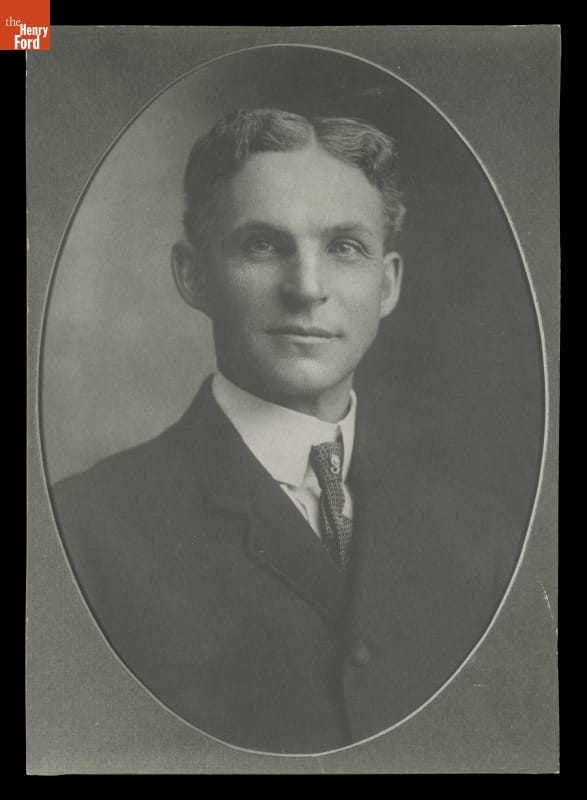
Henry Ford’s first official Ford Motor Company portrait, 1904. / THF97952
Henry Ford did not invent the automobile. But more than any other single individual, he was responsible for transforming the automobile from an invention of unknown utility into an innovation that profoundly shaped the 20th century and continues to affect the 21st. His work at Ford Motor Company revolutionized the automotive industry, setting new standards for production and accessibility.
Innovators change things. They take new ideas—sometimes their own, sometimes other people’s—and develop and promote those ideas until they become an accepted part of daily life. Innovation requires self-confidence, a taste for taking risks, leadership ability, and a vision of what the future should be. Henry Ford had all these characteristics, but it took him many years to develop all of them fully.
Portrait of the Innovator as a Young Man
Ford’s beginnings were perfectly ordinary. He was born on his father’s farm in what is now Dearborn, Michigan, on July 30, 1863. At this time, most Americans were born on farms, and most looked forward to being farmers themselves. Early on, Ford demonstrated some of the characteristics that would make him successful. In his family, he became infamous for taking apart his siblings’ toys as well as his own. He organized other boys to build rudimentary waterwheels and steam engines. He learned about full-size steam engines by becoming acquainted with the engines’ operators and pestering them with questions. He taught himself to fix watches and used the watches themselves as textbooks to learn the basics of machine design. Thus, at an early age, Ford demonstrated curiosity, self-confidence, mechanical ability, the capacity for leadership, and a preference for learning by trial and error. These characteristics would become the foundation of his whole career.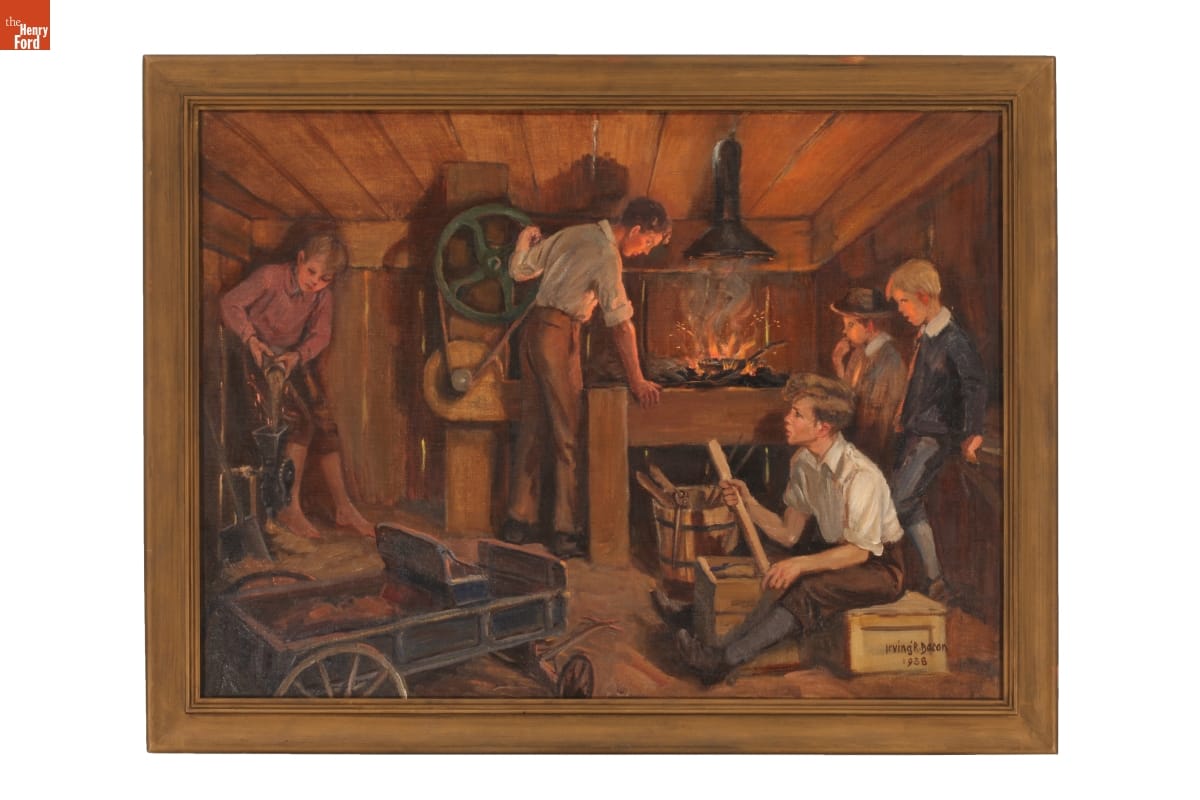
Artist Irving Bacon depicted Henry Ford in his first workshop, along with friends, in this 1938 painting. / THF152920
Ford could simply have followed in his father’s footsteps and become a farmer. But young Henry was fascinated by machines and was willing to take risks to pursue that fascination. In 1879, he left the farm to become an apprentice at a machine shop in Detroit. Over the next few years, he held jobs at several places, sometimes moving when he thought he could learn more somewhere else. He returned home in 1882 but did little farming. Instead, he operated and serviced portable steam engines used by farmers, occasionally worked in factories in Detroit, and cut and sold timber from 40 acres of his father’s land.
By now, Ford was demonstrating another characteristic—a preference for working on his own rather than for somebody else. In 1888, Ford married Clara Bryant, and in 1891 they moved to Detroit. Ford had taken a job as night engineer for the Edison Electric Illuminating Company—another risk on his part, because he did not know a great deal about electricity at this point. He took the job in part as an opportunity to learn.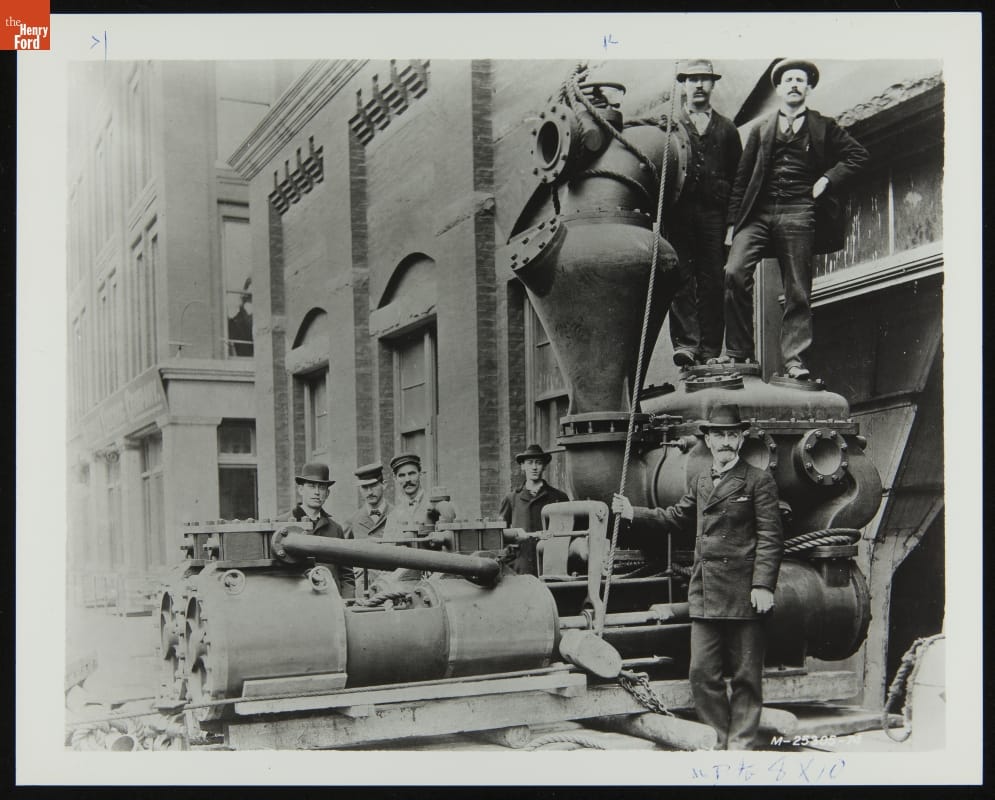
Henry Ford (third from left, in white coat) with other employees at Edison Illuminating Company Plant, November 1895. / THF244633
Early Automotive Experiments: Failure and Then Success
Henry was a skilled student, and by 1896 had risen to chief engineer of the Illuminating Company. But he had other interests. He became one of the scores of other people working in barns and small shops trying to make horseless carriages. Ford read about these other efforts in magazines, copying some of the ideas and adding some of his own, and convinced a small group of friends and colleagues to help him. This resulted in his first primitive automobile, the Quadricycle, completed in 1896. A second, more sophisticated car followed in 1898. These early experiments laid the groundwork for his future endeavors in the automotive industry.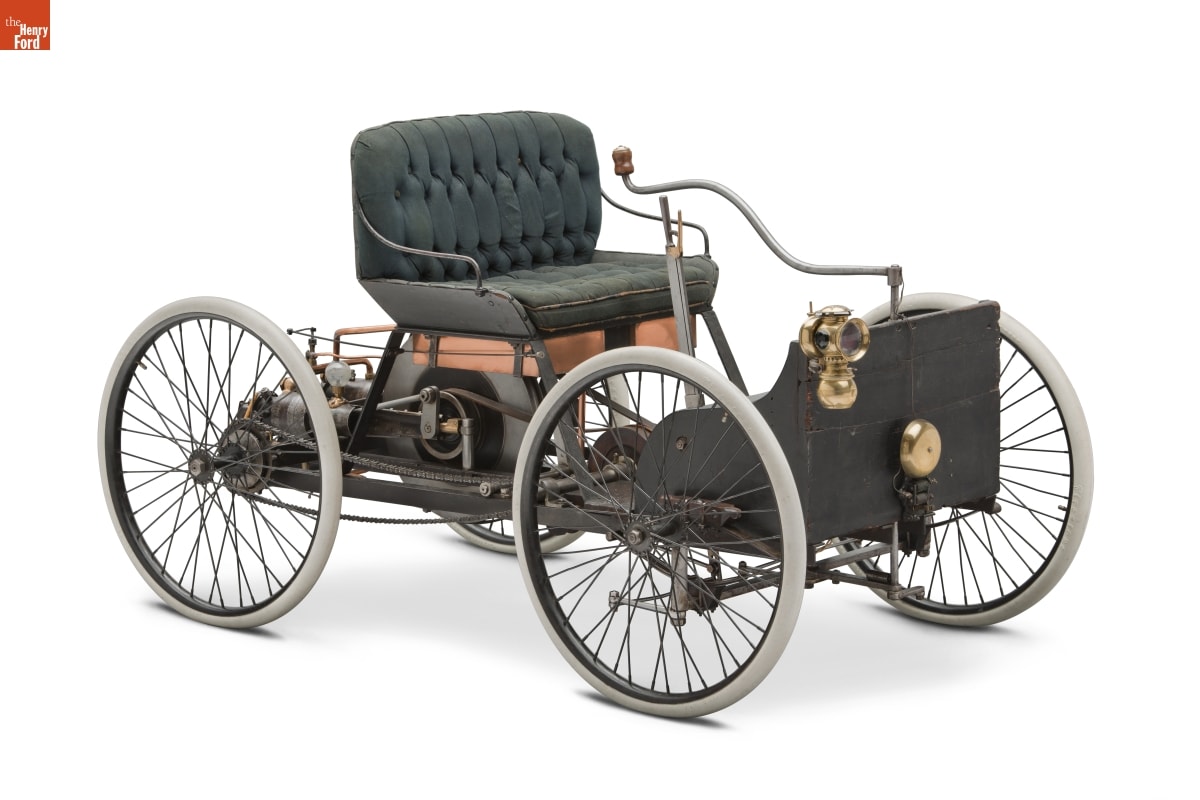
Henry Ford’s 1896 Quadricycle Runabout, the first car he built. / THF90760
Ford now demonstrated one of his most important characteristics—the ability to articulate a vision and convince other people to sign on and help him achieve that vision. He convinced a group of businessmen to back him in the biggest risk of his life—starting a company to make horseless carriages. But Ford knew nothing about running a business, and learning by doing often involves failure. The new company failed, as did a second. His first venture, the Detroit Automobile Company, failed due to the poor quality of its vehicles. Ford tried again, this time with the Henry Ford Company. But disputes over the new company’s direction soon caused Ford and his investors to part ways.
To revive his fortunes, Ford took bigger risks, building and even driving a pair of racing cars. The success of these cars attracted additional financial backers, and on June 16, 1903, just before his 40th birthday, Henry incorporated his third automobile venture, the Ford Motor Company.
The early history of Ford Motor Company illustrates another of Henry Ford’s most valuable traits—his ability to identify and attract outstanding talent. He hired a core of young, highly competent people who would stay with him for years and make Ford Motor Company into one of the world’s great industrial enterprises. He hired a core of young, highly competent people who would stay with him for years, reshaping America’s automotive industry while building Ford Motor Company into one of the world’s great industrial enterprises.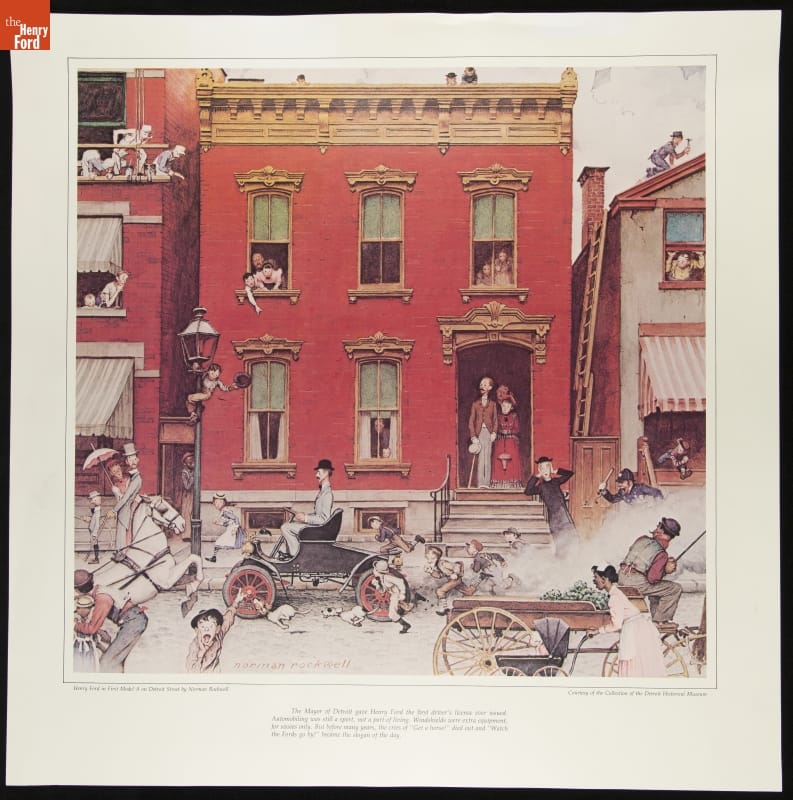
Print of Norman Rockwell's painting, "Henry Ford in First Model A on Detroit Street." / THF288551
The new company’s first car was called the Model A, and a variety of improved models followed. In 1906, Ford’s 4-cylinder, $600 Model N became the best-selling car in the country. But by this time, Ford had a vision of an even better, cheaper “motorcar for the great multitude.” Working with a small group of employees, he came up with the Model T, introduced on October 1, 1908. The Model T was a game-changer, designed to be simple, reliable, and ultimately affordable for the average American.
The Automobile: A Solution in Search of a Problem
As hard as it is for us to believe, in 1908 there was still much debate about exactly what automobiles were good for. We may see them as a necessary part of daily life, but the situation in 1908 was very different. Americans had arranged their world to accommodate the limits of the transportation devices available to them. People in cities got where they wanted to go by using electric street cars, horse-drawn cabs, bicycles, and shoe leather because all the places they wanted to go were located within reach of those transportation modes.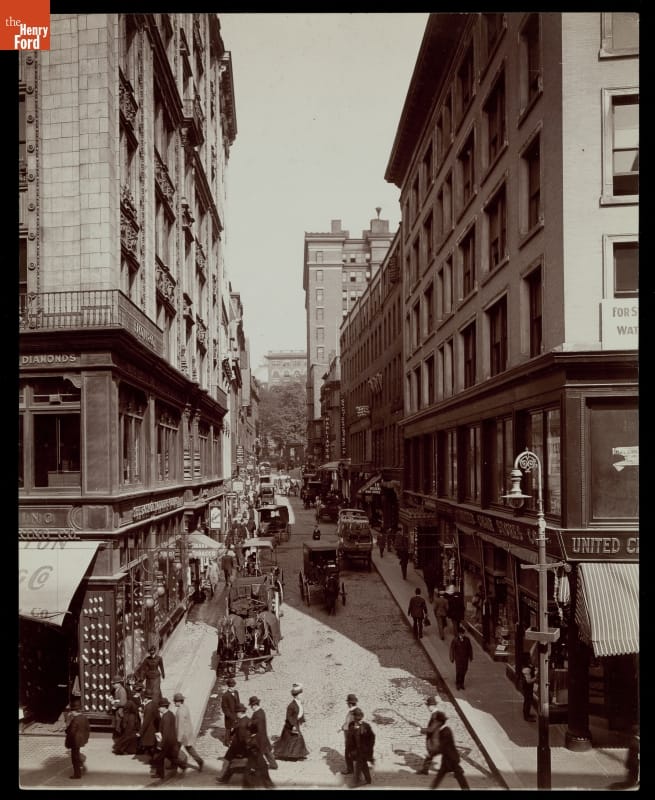
This Boston street scene, circa 1908, shows pedestrians and horse-drawn carriages on the road—but no cars. / THF203438
Most of the commercial traffic in cities still moved in horse-drawn vehicles. Rural Americans simply accepted the limited travel radius of horse- or mule-drawn vehicles. For long distances, Americans used our extensive, well-developed railroad network. People did not need automobiles to conduct their daily activities. Rather, the people who bought cars used them as a new means of recreation. They drove them on joyrides into the countryside. The recreational aspect of these early cars was so important that people of the time divided motor vehicles into two large categories: commercial vehicles, like trucks and taxicabs, and pleasure vehicles, like private automobiles. The term “passenger cars” was still years away. The automobile was an amazing invention, but it was essentially an expensive toy, a plaything for the rich. It was not yet a true innovation.
Henry Ford had a wider vision for the automobile. He summed it up in a statement that appeared in 1913 in the company magazine, Ford Times:
“I will build a motor car for the great multitude. It will be large enough for the family but small enough for the individual to run and care for. It will be constructed of the best materials, by the best men to be hired, after the simplest designs that modern engineering can devise. But it will be so low in price that no man making a good salary will be unable to own one—and enjoy with his family the blessings of hours of pleasure in God’s great open spaces.”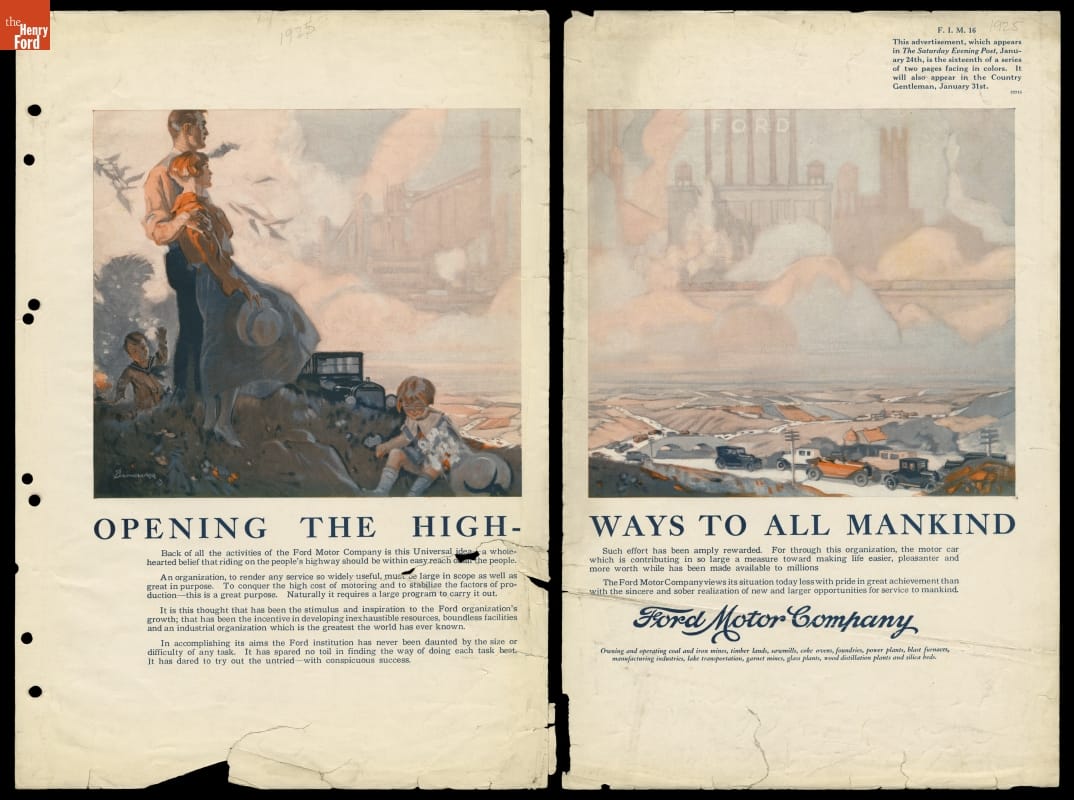
This 1924 Ford ad, part of a series, echoes the vision expressed 11 years earlier by Henry Ford: “Back of all of the activities of the Ford Motor Company is this Universal idea—a wholehearted belief that riding on the people’s highway should be in easy reach of all the people.” / THF95501
It was this vision that moved Henry Ford from inventor and businessman to innovator. To achieve his vision, Ford drew on all the qualities he had been developing since childhood: curiosity, self-confidence, mechanical ability, leadership, a preference for learning by trial and error, a willingness to take risks, and an ability to identify and attract talented people.
One Innovation Leads to Another
Ford himself guided a design team that created a car that pushed technical boundaries. The Model T’s one-piece engine block and removable cylinder head were unusual in 1908 but would eventually become standard on all cars. The Ford’s flexible suspension system was specifically designed to handle the dreadful roads that were then typical in the United States. The designers utilized vanadium alloy steel that was stronger for its weight than standard carbon steel. The Model T was lighter than its competitors, allowing its 20-horsepower engine to give it performance equal to that of more expensive cars. The Model T forever changed the automotive industry and American culture. Its impact can still be felt today.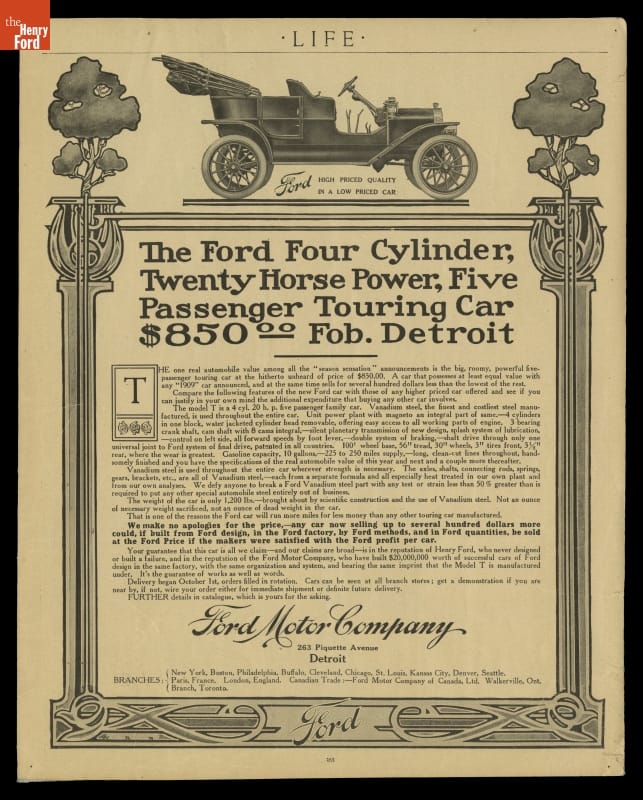
1908 advertisement for the 1909 Ford Model T. In advertisements, Ford Motor Company emphasized key technological features and the low prices of their Model Ts. Ford's usage of vanadium steel enabled the company to make a lighter, sturdier, and more reliable vehicle than other early competitors. / THF122987
The new Ford car proved to be so popular that Henry could easily sell all he could make, but he wanted to be able to make all he could sell. So Ford and his engineers began a relentless drive both to raise the rate at which Model Ts could be produced and to lower the cost of production.
In 1910, the company moved into a huge new factory in Highland Park, a city just north of Detroit. Borrowing ideas from watchmakers, clockmakers, gunmakers, sewing machine makers, and meat processors, Ford Motor Company had, by 1913, developed a moving assembly line for automobiles. But Ford did not limit himself to technical improvements.
When his workforce objected to the relentless, repetitive work that the line entailed, Ford responded with perhaps his boldest idea ever—he doubled wages to $5 per day. With that one move, he stabilized his workforce and gave it the ability to buy the very cars it made. He hired a brilliant accountant named Norval Hawkins as his sales manager. Hawkins created a sales organization and advertising campaign that fueled potential customers’ appetites for Fords. Model T sales rose steadily while the selling price dropped. By 1921, half the cars in America were Model Ts, and a new one could be had for as little as $415.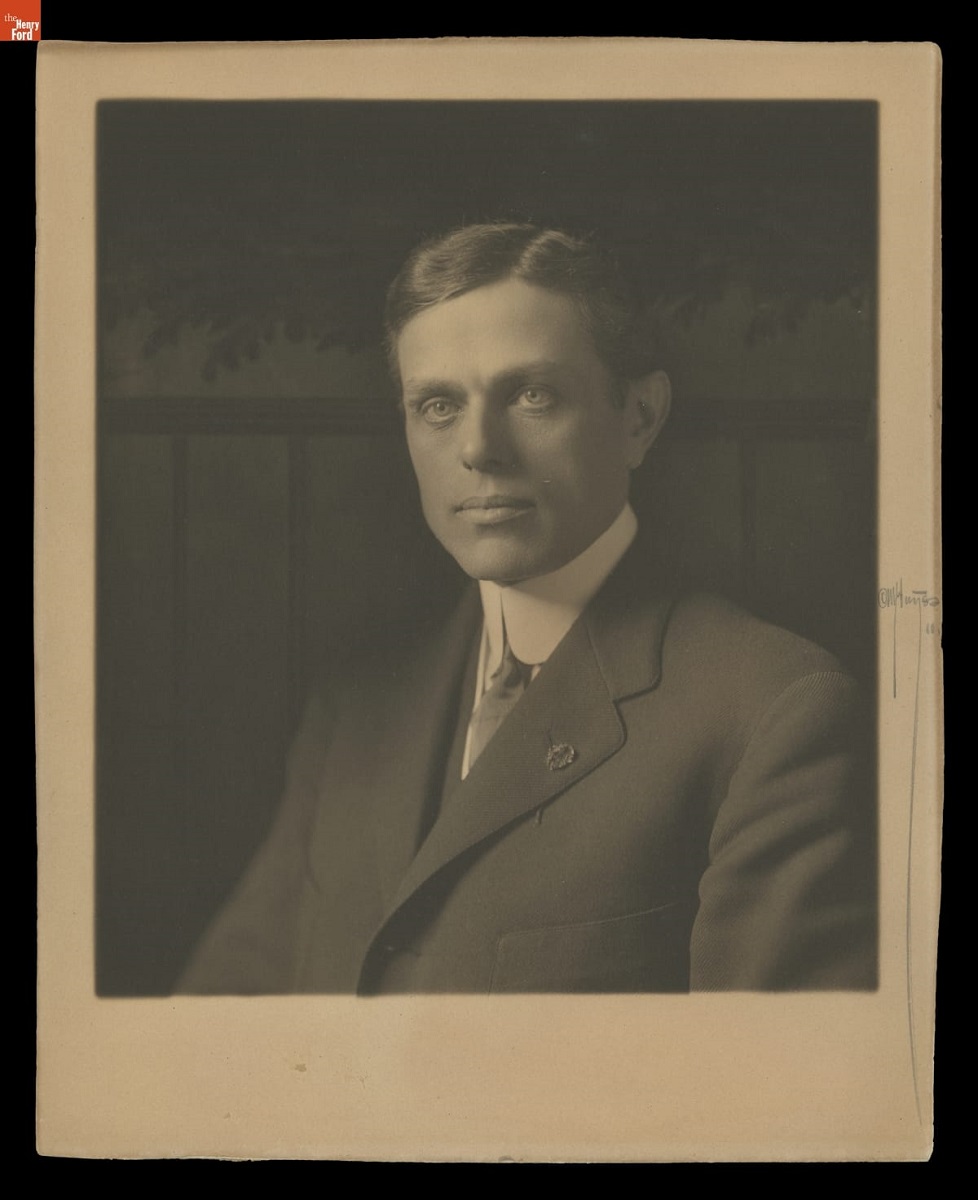
Norval Hawkins headed the sales department at Ford Motor Company for 12 years, introducing innovative advertising techniques and increasing Ford’s annual sales from 14,877 vehicles in 1907 to 946,155 in 1919. / THF145969
Through these efforts, Ford turned the automobile from an invention bought by the rich into a true innovation available to a wide audience. By the 1920s, largely as a result of the Model T’s success, the term “pleasure car” was fading away, replaced by “passenger car.” Ford’s moving assembly line and $5 day ushered in a new era of mass production and affordability. American society itself was transformed as motorists were free to travel where they wanted, when they wanted.
The assembly line techniques pioneered at Highland Park spread throughout the auto industry and into other manufacturing industries as well. The high-wage, low-skill jobs pioneered at Highland Park also spread throughout the manufacturing sector. Advertising themes pioneered by Ford Motor Company are still being used today. Ford’s curiosity, leadership, mechanical ability, willingness to take risks, ability to attract talented people, and vision produced innovations in transportation, manufacturing, labor relations, and advertising. His legacy is preserved at places like Greenfield Village, showcasing his impact on American life and the evolution of the automotive industry.
What We Have Here Is a Failure to Innovate
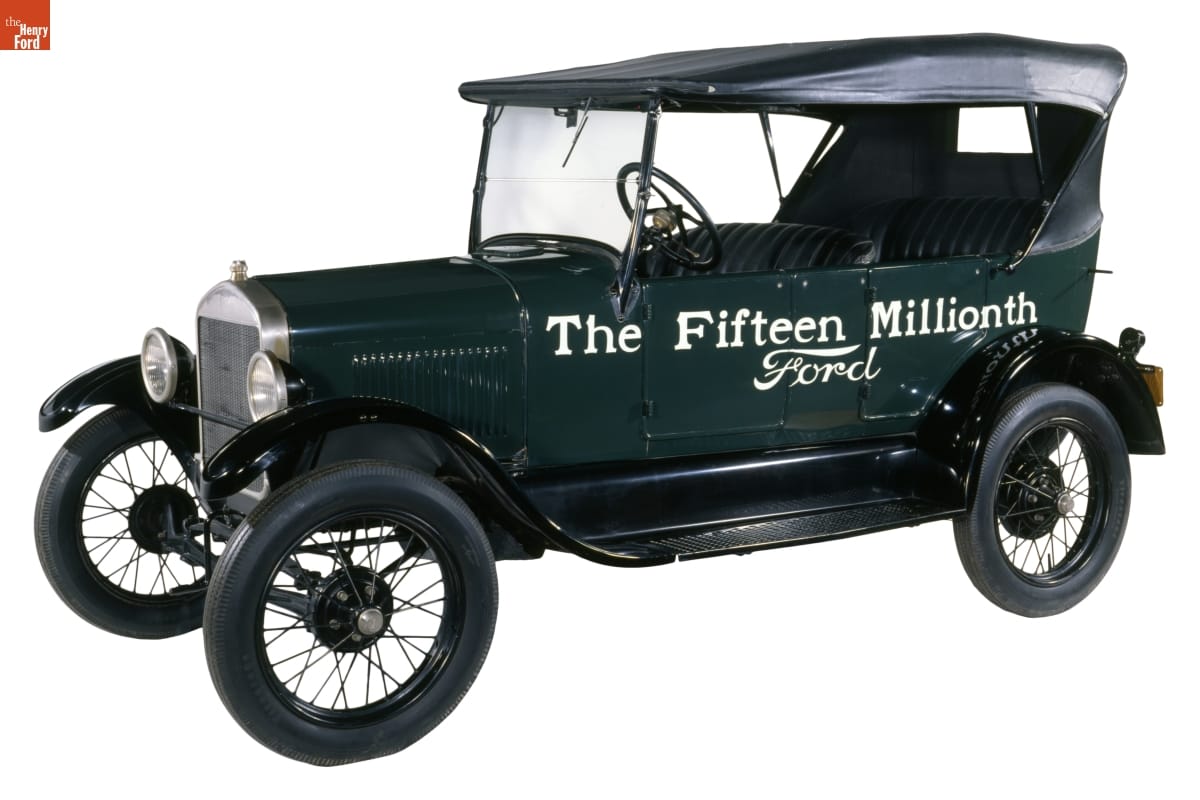
Henry Ford was slow to admit that customers no longer wanted the Model T. However, in 1927, he finally acknowledged that shift, and Henry Ford and his son, Edsel Ford, drove this last Model T—number 15,000,000—off the assembly line at Highland Park. / THF135450
Henry Ford’s great success did not necessarily bring with it great wisdom. In fact, his very success may have blinded him as he looked to the future. The Model T was so successful that he saw no need to significantly change or improve it. He did authorize many detail changes that resulted in lower cost or improved reliability, but there was never any fundamental change to the design he had laid down in 1907.
He was slow to adopt innovations that came from other carmakers, like electric starters, hydraulic brakes, windshield wipers, and more luxurious interiors. He seemed not to realize that the consumer appetites he had encouraged and fulfilled would continue to grow. He seemed not to want to acknowledge that once he started his company down the road of innovation, it would have to keep innovating or else fall behind companies that did innovate. He ignored the growing popularity of slightly more expensive but more stylish and comfortable cars, like the Chevrolet, and would not listen to Ford executives who believed it was time for a new model.
But Model T sales were beginning to slip by 1923, and by the late 1920s, even Henry Ford could no longer ignore the declining sales figures. In 1927, he reluctantly shut down the Model T assembly lines and began the design of an all-new car. It appeared in December 1927 and was such a departure from the old Ford that the company went back to the beginning of the alphabet for a name—it was called the Model A.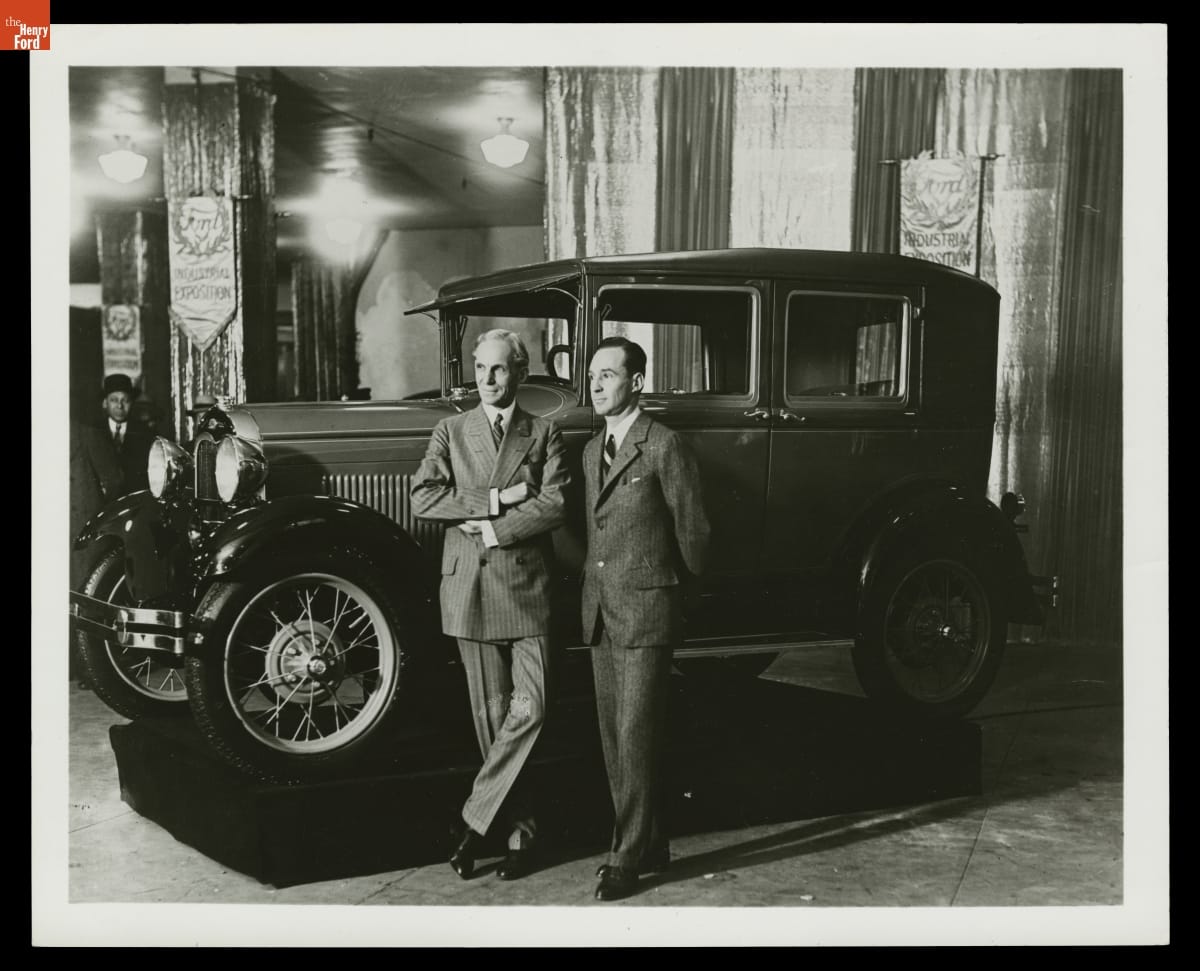
Edsel and Henry Ford introduce the new Model A at the Ford Industrial Exposition in New York in January 1928. Edsel had worked to convince his father to replace the outmoded Model T with something new. / THF91597
One area where Ford did keep innovating was in actual car production. In 1917, he began construction of a vast new plant on the banks of the Rouge River southwest of Detroit. This plant would give Ford Motor Company complete control over nearly all aspects of the production process. Raw materials from Ford mines would arrive on Ford boats, and would be converted into iron and steel, which were transformed into engines, transmissions, frames, and bodies. Glass and tires would be made onsite as well, and all of this would be assembled into completed cars. Assembly of the new Model A was transferred to the Rouge. Eventually the plant would employ 100,000 people and generate many innovations in auto manufacturing. The River Rouge complex became a symbol of Ford's ambition and scale, a testament to his vision for vertically integrated production.
But improvements in manufacturing were not enough to make up for the fact that Henry Ford was no longer a leader in automotive design. The Model A was competitive for only four years before needing to be replaced by a newer model. In 1932, at age 69, Ford introduced his last great automotive innovation, the lightweight, inexpensive V-8 engine. It represented a real technological and marketing breakthrough, but in other areas Fords continued to lag behind their competitors. The Ford factory continued to evolve, but the company faced new challenges in keeping up with changing consumer preferences and technological advancements in the automotive industry.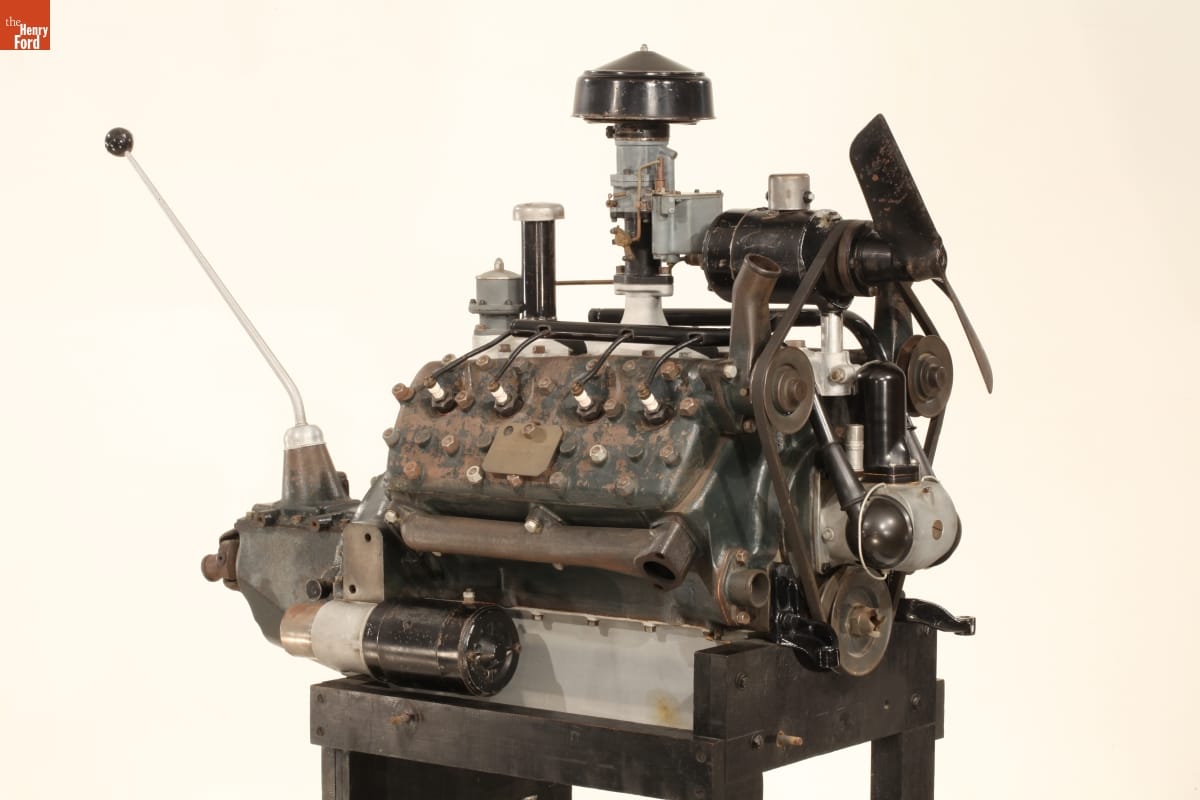
The V-8 engine was Henry Ford’s last great automotive innovation. This is the first V-8 engine produced, which is on exhibit in Henry Ford Museum of American Innovation. / THF101039
By 1936, the company that once sold half of the cars made in America had fallen to third place behind both General Motors and the upstart Chrysler Corporation. By the time Henry Ford died in 1947, his great company was in serious trouble, and a new generation of innovators, led by his grandson Henry Ford II, would work long and hard to restore it to its former glory. Henry’s story is a textbook example of the power of innovation—and the power of its absence. His contributions to the automotive industry and American society are undeniable, but his later resistance to change serves as a cautionary tale.
Bob Casey is former Curator of Transportation at The Henry Ford. This post is adapted from an educational document from The Henry Ford titled “Henry Ford and Innovation: From the Curators.”
Detroit, Michigan, Dearborn, 20th century, 19th century, quadricycle, Model Ts, manufacturing, Henry Ford, Ford Rouge Factory Complex, Ford Motor Company, entrepreneurship, engines, engineering, cars, by Bob Casey, advertising
“Whenever Henry Ford visited England, he always liked to spend a few days in the Cotswold Country, of which he was very fond … during these sojourns I had many happy times driving Mr. Ford around the lovely scenes which abound in this part of Britain.”
—Herbert Morton, Strange Commissions for Henry Ford
A winding road through a Cotswold village, October 1930. / THF148434, detail
The Cotswolds Catch Henry Ford’s Eye
Henry Ford loved the Cotswolds, a rural region in southwest England—nearly 800 square miles of rolling hills, pastures, and small villages.
During the Middle Ages, a vibrant wool trade brought the Cotswolds great prosperity—at its heart was a breed of sheep known as Cotswold Lions. For centuries, the Cotswold region was well-known throughout Europe for the quality of its wool. Raising sheep, trading in wool, and woolen cloth fueled England’s economic growth from the Middle Ages to the Industrial Revolution. Cotswold’s prosperity and its rich belt of limestone that provided ready building material resulted in a distinctive style of architecture: limestone homes, churches, shops, and farm buildings of simplicity and grace.
During Henry Ford’s trips to the Cotswolds in the 1920s, he became intrigued with the area’s natural beauty and charming architecture—all those lovely stone buildings that “blossomed” among the verdant green countryside and clustered together in Cotswold’s picturesque villages. By early 1929, Ford had decided he wanted to acquire and move a Cotswold home to Greenfield Village.
A letter dated February 4, 1929, from Ford secretary Frank Campsall described that Ford was looking for “an old style that has not had too many changes made to it that could be restored to its true type.” Herbert Morton, Ford’s English agent, was assigned the task of locating and purchasing a modest building “possessing as many pretty local features as might be found.” Morton began to roam the countryside looking for just such a house. It wasn’t easy. Cotswold villages were far apart, so his search covered an extensive area. Owners of desirable properties were often unwilling to sell. Those buildings that were for sale might have only one nice feature—for example, a lovely doorway, but no attractive window elements.
Cotswold Cottage (buildings shown at left) nestled among the rolling hills in Chedworth, 1929–1930. / THF236012
Herbert Morton was driving through the tiny village of Lower Chedworth when he saw it. Constructed of native limestone, the cottage had “a nice doorway, mullions to the windows, and age mellowed drip-stones.” Morton knew he had found the house he had been looking for. It was late in the day, and not wanting to knock on the door and ask if the home was for sale, Morton returned to the town of Cheltenham, where he was staying.
The next morning Morton strolled along a street in Cheltenham, pondering how to approach the home’s owner. He stopped to look into a real estate agent’s window—and saw a photograph of the house, which was being offered for sale! Later that day, Morton arrived in Chedworth, and was greeted by the owner, Margaret Cannon Smith, and her father. The cottage, constructed out of native limestone in the early 1600s, had begun life as a single cottage, with the second cottage added a bit later.
Interior of Cotswold Cottage, 1929-1930. / THF236052
The home was just as quaint inside—large open fireplaces with the mantels supported on oak beams. Heavy oak beams graced the ceilings and the roof. Spiral stone staircases led to the second floor. Morton bought the house and the two acres on which it stood under his own name from Margaret Smith in April 1929 for approximately $5000. Ford’s name was kept quiet. Had the seller been aware that the actual purchaser was Henry Ford, the asking price might have been higher.
Cotswold Cottage (probably built about 1619) as it looked when Herbert Morton spotted it, 1929–1930. / THF236020
“Perfecting” the Cotswold Look
Over the next several months, Herbert Morton and Frank Campsall, Ford’s personal secretary, traded correspondence concerning repairs and (with the best of intentions on Ford’s part) some “improvements” Ford wanted done to the building: the addition of architectural features that best exemplified the Cotswold style. Morton sent sketches, provided by builder and contractor W. Cox-Howman from nearby Stow-on-the-Wold, showing typical Cotswold architectural features not already represented in the cottage from which to choose. Ford selected the sketch which offered the largest number of typical Cotswold features.
Ford’s added features on the left cottage included a porch (a copy of one in the Cotswold village of Rissington), a dormer window, a bay window, and a beehive oven.
Cotswold Cottage, 1929–1930, showing modifications requested by Henry Ford: the beehive oven, porch, and dormer window. / THF235980
Bay window added to the left cottage by Henry Ford (shown 1929–1930). Iron casement windows were added throughout. / THF236054
The cottage on the right got a doorway “makeover” and some dove-holes. These holes are commonly found in the walls of barns, but not in houses. It would have been rather unappealing to have bird droppings so near the house!

Ford’s modifications to the right cottage—a new doorway (top) and dove-holes (bottom) on the upper wall. / THF236004, THF235988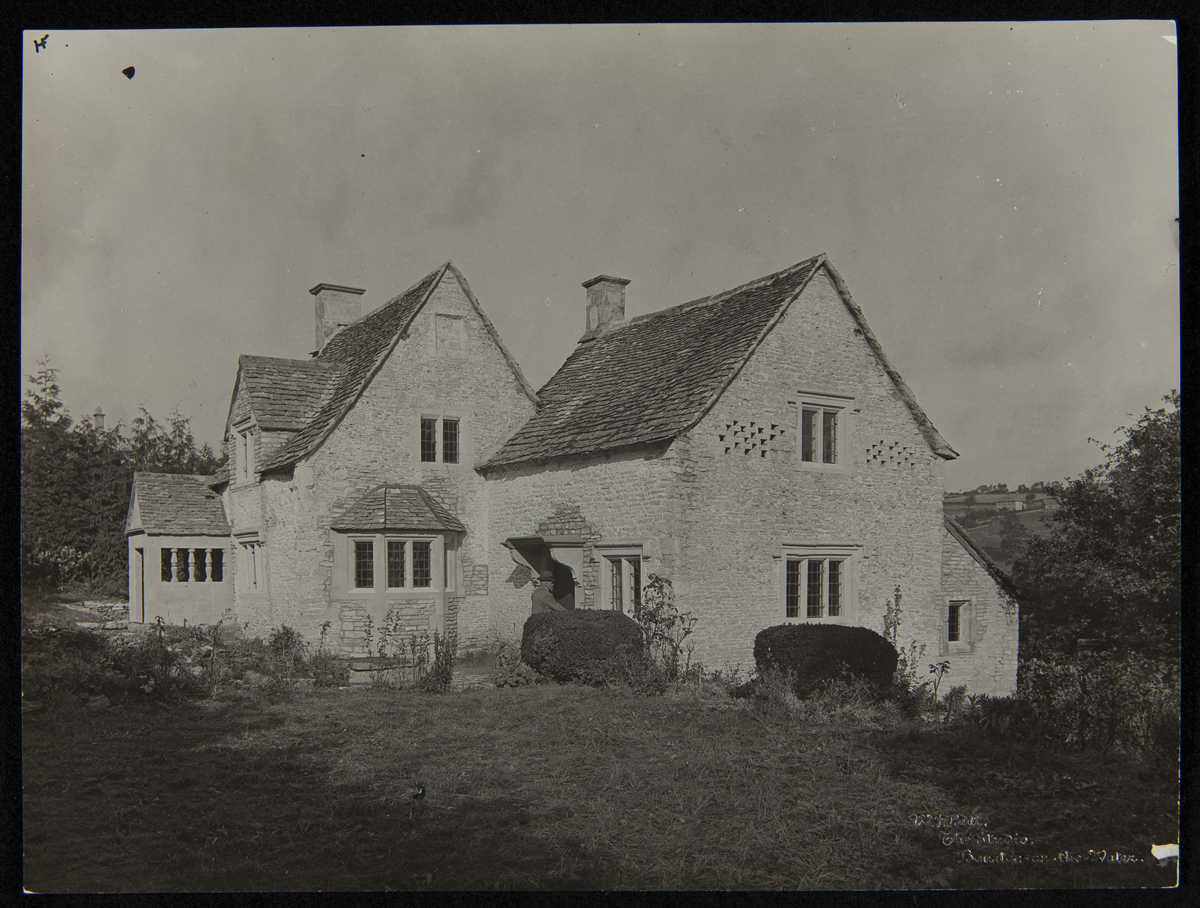
Cotswold Cottage, now sporting Henry Ford’s desired alterations. / THF235984
Ford wanted the modifications completed before the building was disassembled—perhaps so that he could establish the final “look” of the cottage, as well as be certain that there were sufficient building materials. The appearance of the house now reflected both the early 1600s and the 1920s—each of these time periods became part of the cottage’s history. Ford’s additions, though not original to the house, added visual appeal.
The modifications were completed by early October 1929. The land the cottage stood on was transferred to the Ford Motor Company and later sold.
Cotswold Cottage Comes to America

Cotswold Cottage being disassembled. / THF148471
By January 1930, the dismantling of the modified cottage was in process. To carry out the disassembly, Morton again hired local contractor W. Cox-Howman.
Building components being crated for shipment to the United States. / THF148475
Doors, windows, staircases, and other architectural features were removed and packed in 211 crates.
Cotswold building stones ready for shipment in burlap sacks. / THF148477
The building stones were placed in 506 burlap sacks.
Cotswold barn and stable on original site, 1929–1930. / THF235974
The adjacent barn and stable, as well as the fence, were also dismantled and shipped along with the cottage.
Hauled by a Great Western Railway tank engine, 67 train cars transported the materials from the Cotswolds to London to be shipped overseas. / THF132778
The disassembled cottage, fence, and stable—nearly 500 tons worth—were ready for shipment in late March 1930. The materials were loaded into 67 Great Western Railway cars and transported to Brentford, west London, where they were carefully transferred to the London docks. From there, the Cotswold stones crossed the Atlantic on the SS London Citizen.
As one might suspect, it wasn’t a simple or inexpensive move. The sacks used to pack many of the stones were in rough condition when they arrived in New Jersey—at 600 to 1200 pounds per package, the stones were too heavy for the sacks. So, the stones were placed into smaller sacks that were better able to withstand the last leg of their journey by train from New Jersey to Dearborn. Not all of the crates were numbered; some that were had since lost their markings. One package went missing and was never accounted for—a situation complicated, perhaps, by the stones having been repackaged into smaller sacks.
Despite the problems, all the stones arrived in Dearborn in decent shape—Ford’s project manager/architect, Edward Cutler, commented that there was no breakage. Too, Herbert Morton had anticipated that some roof tiles and timbers might need to be replaced, so he had sent some extra materials along—materials taken from old cottages in the Cotswolds that were being torn down.
Cotswold “Reborn”
In April 1930, the disassembled Cotswold Cottage and its associated structures arrived at Greenfield Village. English contractor Cox-Howman sent two men, mason C.T. Troughton and carpenter William H. Ratcliffe, to Dearborn to help re-erect the house. Workers from Ford Motor Company’s Rouge Plant also came to assist. Reassembling the Cotswold buildings began in early July, with most of the work completed by late September. Henry Ford was frequently on site as Cotswold Cottage took its place stone-by-stone in Greenfield Village.
Before the English craftsmen returned home, Clara Ford arranged a special lunch at the cottage, with food prepared in the cottage’s beehive oven. The men also enjoyed a sight-seeing trip to Niagara Falls before they left for England in late November.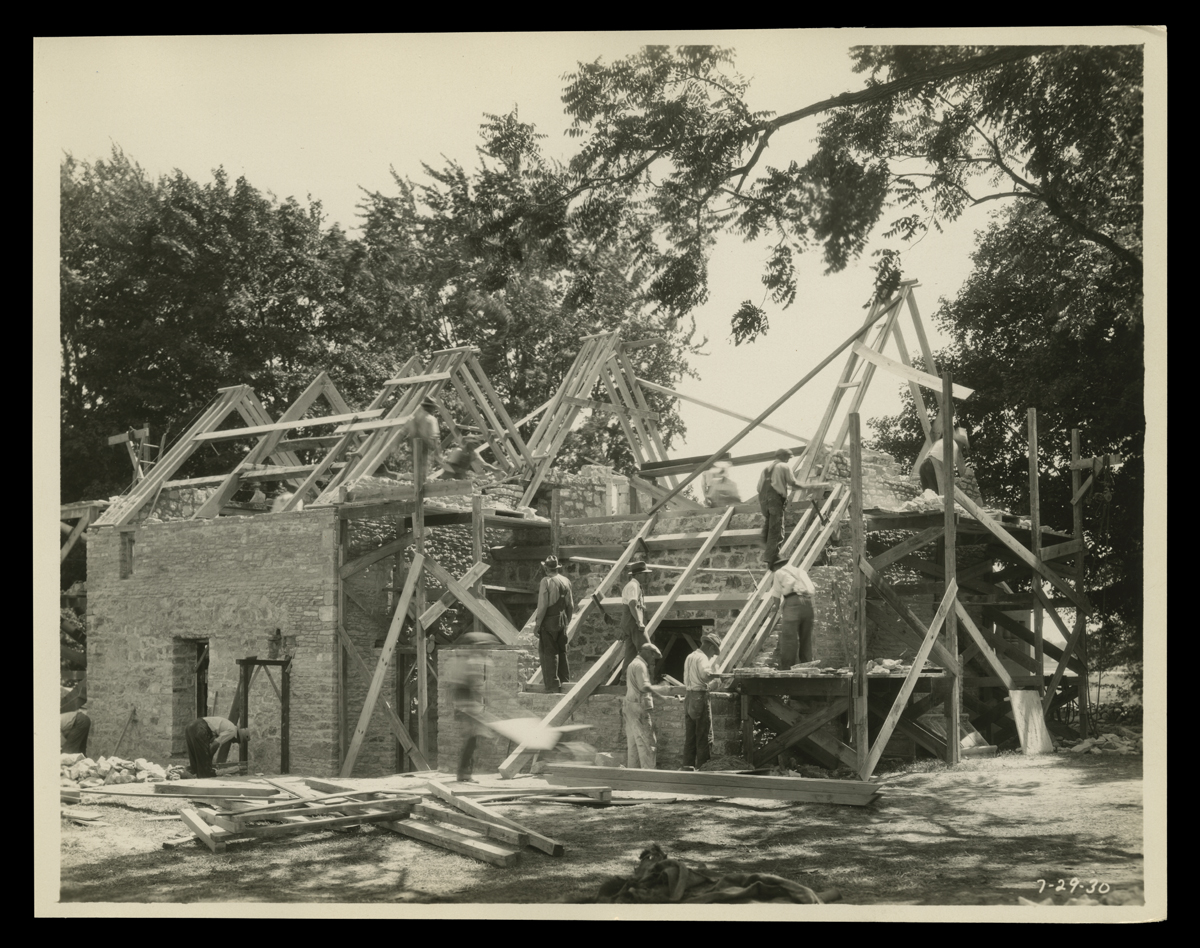
By the end of July 1930, the cottage walls were nearly completed. / THF148485
On August 20, 1930, the buildings were ready for their shingles to be put in place. The stone shingles were put up with copper nails, a more modern method than the wooden pegs originally used. / THF148497
Cotswold barn, stable, and dovecote, photographed by Michele Andonian. / THF53508
Free-standing dovecotes, designed to house pigeons or doves which provided a source of fertilizer, eggs, and meat, were not associated with buildings such as Cotswold Cottage. They were found at the homes of the elite. Still, for good measure, Ford added a dovecote to the grouping about 1935. Cutler made several plans and Ford chose a design modeled on a dovecote in Chesham, England.
Henry and Clara Ford Return to the Cotswolds

The Lygon Arms in Broadway, where the Fords stayed when visiting the Cotswolds. / THF148435, detail
As reconstruction of Cotswold Cottage in Greenfield Village was wrapping up in the fall of 1930, Henry and Clara Ford set off for a trip to England. While visiting the Cotswolds, the Fords stayed at their usual hotel, the Lygon Arms in Broadway, one of the most frequently visited of all Cotswold villages.
Henry (center) and Clara Ford (second from left) visit the original site of Cotswold Cottage, October 1930. / THF148446, detail
While in the Cotswolds, Henry Ford unsurprisingly asked Morton to take him and Clara to the site where the cottage had been.
Cotswold village of Stow-on-the-Wold, 1930. / THF148440, detail
At Stow-on-the-Wold, the Fords called on the families of the English mason and carpenter sent to Dearborn to help reassemble the Cotswold buildings.
Village of Snowshill in the Cotswolds. / THF148437, detail
During this visit to the Cotswolds, the Fords also stopped by the village of Snowshill, not far from Broadway, where the Fords were staying. Here, Henry Ford examined a 1600s forge and its contents—a place where generations of blacksmiths had produced wrought iron farm equipment and household objects, as well as iron repair work, for people in the community.
The forge on its original site at Snowshill, 1930. / THF146942
A few weeks later, Ford purchased the dilapidated building. He would have it dismantled, and then shipped to Dearborn in February 1931. The reconstructed Cotswold Forge would take its place near the Cotswold Cottage in Greenfield Village.
To see more photos taken during Henry and Clara Ford’s 1930 tour of the Cotswolds, check out this photograph album in our Digital Collections.
Cotswold Cottage Complete in Greenfield Village—Including Wooly “Residents”

Completed the previous fall, Cotswold Cottage is dusted with snow in this January 1931 photograph. Cotswold sheep gather in the barnyard, watched over by Rover, Cotswold’s faithful sheepdog. (Learn Rover's story here.) / THF623050
A Cotswold sheep (and feline friend) in the barnyard, 1932. / THF134679
Beyond the building itself, Henry Ford brought over Cotswold sheep to inhabit the Cotswold barnyard. Sheep of this breed are known as Cotswold Lions because of their long, shaggy coats and faintly golden hue.
Cotswold Cottage stood ready to welcome—and charm—visitors when Greenfield Village opened to the public in June 1933. / THF129639
By the Way: Who Once Lived in Cotswold Cottage?

Cotswold Cottage, as it looked in the early 1900s. From Old Cottages Farm-Houses, and Other Stone Buildings in the Cotswold District, 1905, by W. Galsworthy Davie and E. Guy Dawber. / THF284946
Before Henry Ford acquired Cotswold Cottage for Greenfield Village, the house had been lived in for over 300 years, from the early 1600s into the late 1920s. Many of the rapid changes created by the Industrial Revolution bypassed the Cotswold region and in the 1920s, many area residents still lived in similar stone cottages. In previous centuries, many of the region’s inhabitants had farmed, raised sheep, worked in the wool or clothing trades, cut limestone in the local quarries, or worked as masons constructing the region’s distinctive stone buildings. Later, silk- and glove-making industries came to the Cotswolds, though agriculture remained important. By the early 1900s, tourism became a growing part of the region’s economy.
A complete history of those who once occupied Greenfield Village’s Cotswold Cottage is not known, but we’ve identified some of the owners since the mid-1700s. The first residents who can be documented are Robert Sley and his wife Mary Robbins Sley in 1748. Sley was a yeoman, a farmer who owned the land he worked. From 1790 at least until 1872, Cotswold was owned by several generations of Robbins descendants named Smith, who were masons or limeburners (people who burned limestone in a kiln to obtain lime for mixing with sand to make mortar).
As the Cotswold region gradually evolved over time, so too did the nature of some of its residents. From 1920 to 1923, Austin Lane Poole and his young family owned the Cotswold Cottage. Medieval historian, fellow, and tutor at St. John’s College at Oxford University (about 35 miles away), Poole was a scholar who also enjoyed hands-on work improving the succession of Cotswold houses that he owned. Austin Poole had gathered documents relating to the Sley/Robbins/Smith families spanning 1748 through 1872. It was these deeds and wills that revealed the names of some of Cotswold Cottage’s former owners. In 1937, after learning that the cottage had been moved to Greenfield Village, Poole gave these documents to Henry Ford.
In 1926, Margaret Cannon Smith purchased the house, selling it in 1929 to Herbert Morton, on Henry Ford’s behalf.
“Olde English” Captures the American Imagination
At the time that Henry Ford brought Cotswold Cottage to Greenfield Village, many Americans were drawn to historic English architectural design—what became known as Tudor Revival. The style is based on a variety of late Middle Ages and early Renaissance English architecture. Tudor Revival, with its range of details reminiscent of thatched-roof cottages, Cotswold-style homes, and grand half-timbered manor houses, became the inspiration for many middle-class and upper-class homes of the 1920s and 1930.
These picturesque houses filled suburban neighborhoods and graced the estates of the wealthy. Houses with half-timbering and elaborate detail were often the most obvious examples of these English revival houses, but unassuming cottage-style homes also took their place in American towns and cities. Mansion or cottage, imposing or whimsical, the Tudor Revival house was often made of brick or stone veneer, was usually asymmetrical, and had a steep, multi-gabled roof. Other characteristics included entries in front-facing gables, arched doorways, large stone or brick chimneys (often at the front of the house), and small-paned casement windows.
Edsel Ford’s home at Gaukler Pointe, about 1930. / THF112530
Henry Ford’s son Edsel and his wife Eleanor built their impressive but unpretentious home, Gaukler Pointe, in the Cotswold Revival style in the late 1920s.
Postcard, Postum Cereal Company office building in Battle Creek, Michigan, about 1915. / THF148469
Tudor Revival design found its way into non-residential buildings as well. The Postum Cereal Company (now Post Cereals) of Battle Creek, Michigan, chose to build an office building in this centuries-old English style.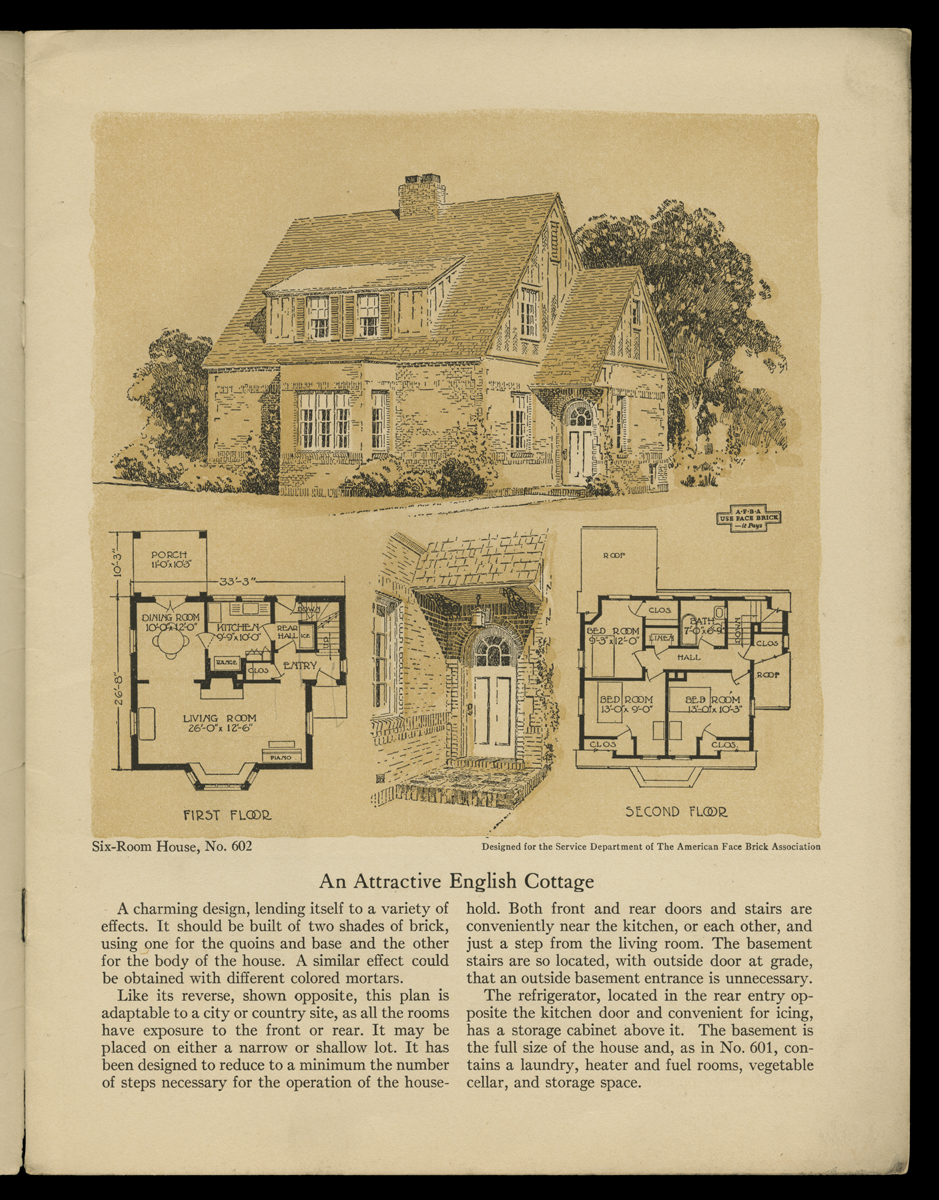
Plan for “An Attractive English Cottage” from the American Face Brick Association plan book, 1921. / THF148542


Plans for English-inspired homes offered by Curtis Companies Inc., 1933. / THF148549, THF148550, THF148553
Tudor Revival homes for the middle-class, generally more common and often smaller in size, appeared in house pattern books of the 1920s and 1930s.
Sideboard, part of a dining room suite made in the English Revival style, 1925–1930. / THF99617
The Tudor Revival called for period-style furnishings as well. “Old English” was one of the most common designs found in fashionable dining rooms during the 1920s and 1930s.
Christmas card, 1929. / THF4485
Even English-themed Christmas cards were popular.
Cotswold Cottage—A Perennial Favorite

Cotswold Cottage in Greenfield Village, photographed by Michelle Andonian. / THF53489
Henry Ford was not alone in his attraction to the distinctive architecture of the Cotswold region and the English cottage he transported to America. Cotswold Cottage remains a favorite with many visitors to Greenfield Village, providing a unique and memorable experience.
Jeanine Head Miller is Curator of Domestic Life at The Henry Ford. Many thanks to Sophia Kloc, Office Administrator for Historical Resources at The Henry Ford, for editorial preparation assistance with this post.
Additional Readings:
- Cotswold Cottage Tea
- Interior of Cotswold Cottage at its Original Site, Chedworth, Gloucestershire, England, 1929-1930
- Cotswold Cottage
home life, design, farm animals, travel, Henry Ford, Greenfield Village buildings, Greenfield Village history, Greenfield Village, by Jeanine Head Miller
"Veterans of the Late Unpleasantness": A Brief History of the Grand Army of the Republic

Artwork Used in a Grand Army of the Republic (G.A.R.) Hall in Bath, Maine, circa 1866 / THF119558
Following the end of the Civil War, numerous fraternal veterans’ societies were formed. These societies enabled veterans to socialize with individuals who had similar experiences and also allowed them to work towards similar goals.
Dr. Benjamin Franklin Stephenson formed the Grand Army of the Republic (G.A.R.) for all honorably discharged Union veterans on April 6, 1866, in Decatur, Illinois, and it quickly grew to encompass ten states and the District of Columbia. The G.A.R.’s growth was astronomical, peaking in the 1890s with nearly 400,000 members spread out through almost 9,000 posts in all 50 states, as well as a few in Canada, one in Mexico, and one in Peru. These posts were organized into departments, which were typically divided by state, but could include multiple states depending on the population of Union veterans in the area.
Woman's Relief Corps (W.R.C.) Conductor Badge, 1883-1920 / THF254030
Daughters of Union Veterans of the Civil War Membership Badge, circa 1900 / THF254033
The tenets of the G.A.R. were “Fraternity, Charity, and Loyalty,” and are depicted in the seal of the G.A.R. The fraternity aspect was met by fraternal gatherings such as meetings, as well as annual reunions known as encampments at the departmental and national level. Charity was demonstrated through fundraising for veterans’ issues, including welfare, medical assistance, and loans until work could be found, as well as opening soldiers’ and sailors’ homes and orphanages. Loyalty was demonstrated in several ways, including erecting monuments, preserving Civil War sites and relics, donating cannons and other relics to be displayed in parks and courthouses, and donating battle flags to museums. The G.A.R. was assisted in all of their work by their auxiliary organizations, known as the Allied Orders of the G.A.R.: the Women’s Relief Corps, Ladies of the Grand Army of the Republic, Sons of Union Veterans of the Civil War (SUVCW), the Auxiliary to the SUVCW, and the Daughters of Union Veterans of the Civil War—all of which are still active today.
THF623379
Additionally, the G.A.R. was instrumental in having the tradition of memorializing the dead and decorating their graves recognized as the federal holiday Memorial Day, formerly known as Decoration Day. From its origins in smaller, localized observances throughout the country, it gained national recognition after Commander-in-Chief General John A. Logan issued a proclamation on May 30, 1868. Programs like the one above detail the order of events of these celebrations, and some even detail how to appropriately contribute.
Members of the Grand Army of the Republic (G.A.R.) Visiting Mount Vernon, September 21, 1892 / THF254036
The annual and national encampments were not just big events for the G.A.R. and the Allied Orders of the G.A.R, but also for the railroads and cities in which the encampments were held. Railroad companies, such as the Maine Central Railroad Company, advertised the encampments and offered round-trip tickets to attendees. A typical schedule of events for encampments included speeches, business meetings where delegates voted on resolutions and other organizational business, receptions for the G.A.R. and the Allied Orders, parades reminiscent of the Grand Review of the Armies following the end of the Civil War, campfire activities, concerts, outings to nature or historic points of interest, and reunions of other groups, including regimental and other veteran organizations. Attendees to the 1892 Washington, D.C., National Encampment were able to visit Mount Vernon.
THF254025
THF254026
Members would show up in their uniforms, which often included hats with G.A.R. insignia, as well as their G.A.R. membership badge, an example of which can be seen above. Membership badges denoted the wearer’s rank at the time they mustered out and would also show what rank within the G.A.R. they held; Commander-in-Chief badges would be substantially more ornate.
In addition to their membership badges, attendees would also represent their home state, posts, or departments with ribbons or badges stating where they were from. An example is the Forsyth Post badge used at the 1908 Toledo, Ohio National Encampment. These ribbon badges are all unique to the host city—for instance, Detroit’s national encampments’ badges featured an image of Antoine de la Mothe Cadillac sailing to Detroit, signifying the city’s founding in 1701; national encampments held in California typically featured a grizzly bear, like their state flag; Denver’s 1905 National Encampment featured a cowboy on a bucking bronco; and Holland, Michigan’s 1904 and 1910 Annual Encampments featured wooden shoes and windmills.
THF254023
THF254031
Badges help tell the story of the G.A.R., and make these events more relatable to modern audiences—who hasn’t bought a souvenir on vacation or at an event? Beginning in 1882, The G.A.R. produced official souvenir badges for purchase in addition to the membership badges. Some of these souvenirs were made from captured Confederate cannons authorized for destruction by acts of Congress. In the case of the G.A.R., badges were so important that in the 50th Congress, 1st Session, a bill (Report No. 784) was passed to “prevent the unlawful wearing of the badge or insignia of the Grand Army of the Republic or other soldier organizations.”
Watching the highly decorated G.A.R. members march in the parade was a sight that drew many thousands of spectators wherever the encampments were held. The members would have likely marched in their G.A.R. uniforms, which included a double-breasted, dark blue coat with G.A.R. buttons and a hat (either kepi or slouch felt) with G.A.R. insignia. Other uniform pieces, such as leather gauntlets with G.A.R. insignia, are known to exist, but they do not appear to be commonplace. As they had done in the Grand Review of the Armies, they would march with their flags. In 2013, one such flag was conserved by The Henry Ford, as documented in this blog post: “Conserving a G.A.R. Parade Flag.”
Grand Army of the Republic Parade at Campus Martius, Detroit, Michigan, 1881 / THF623825
As the G.A.R. members aged, the number capable of walking an entire parade route dwindled, but luckily for them, the rise of the automobile ensured that they could still participate. For veterans who did not take their personal automobiles to the encampments, calls were sent out to round up enough vehicles to provide each veteran with a car for the parade. In the case of the 1920 Indianapolis National Encampment, John B. Orman, Automobile Committee Chairman, sought to get enough automobiles for all of the veterans requiring them and said “The ‘boys’ of ’61 are no longer boys. Today the distance from the monument erected to their memory to Sixteenth Street is longer than the red road from Sumter to Appomattox.” Local dealerships loaned their cars for the parade, much like today’s parade sponsors sending cars or attaching their names to floats in parades.
At the 83rd and final G.A.R. National Encampment, held in Indianapolis, Indiana, in 1949, six of the last sixteen G.A.R. members not only made the trip to Indianapolis but were able to “march” in the final parade—thanks to the automobile.
Joseph Clovese, one of the six to have participated in the final parade, can be seen with fellow G.A.R. members adorned with their G.A.R. badges on his Find a Grave page. Clovese was born into slavery on a plantation at St. Bernard Parish, Louisiana, in 1844. He joined the Union Army during the siege of Vicksburg as a drummer boy, and then later became an infantryman in the 2nd Missouri Colored Infantry Regiment (later the 65th U.S. Colored Troops Regiment). Following the war, Clovese worked on riverboats on the Mississippi River and assisted with the construction of the first telegraph line between New Orleans, Louisiana, and Biloxi, Mississippi.
Clovese received a citation and medal at the “Blue and Gray” reunion, the 75th anniversary of the Battle of Gettysburg in 1938. At age 104, he moved to Pontiac, Michigan, with his niece, and, according to his obituary in the New York Times, he would take daily walks and was hardly ever ill. He died July 13, 1951, in the Dearborn Veterans Hospital at the age of 107. More information about his long and fascinating life, as well as additional photos of him wearing his G.A.R. badges, can be seen in his Fold3 Gallery.
The G.A.R. officially dissolved in 1956 with the death of the last member, Albert Woolson, but the spirit of the organization lives on through the Allied Orders of the G.A.R.
For additional looks at the G.A.R., check out the other G.A.R. artifacts in our Digital Collections and read a past blog post, “Fraternity, Charity, Loyalty: Remembering the Grand Army of the Republic.”
Laura Myles is Collections Specialist at The Henry Ford.
20th century, 19th century, veterans, philanthropy, holidays, Grand Army of the Republic, Civil War, by Laura Myles, African American history
Flowers: Deep Roots

Trade Card for Choice Flower Seeds, D.M. Ferry & Co., 1880-1900 / THF214403
Sustenance is not usually associated with flowers or the horticultural industry, but cut flowers and ornamental plants have been nourishing humans for centuries. Flowers aid people through hard times by providing joy, mental health benefits, and ephemeral beauty unmatched in many eyes. Additionally, cut flower cultivation is a critical source of revenue and ecosystem service for agricultural entrepreneurs.
Stereograph of a blooming tree peony, circa 1865 / THF66255
The horticulture industry grew rapidly during the 19th century. New businesses, such as Mount Hope Nursery and Gardens out of Rochester, New York, used an expanding transportation infrastructure to market ornamental plants to Midwesterners starting during the 1840s. Yet, while consumers’ interest in ornamentation grew, so did their displeasure with distant producers distributing plants of unverifiable quality. Soon enough, local seed companies and seedling and transplant growers met Detroiters’ needs, establishing greater levels of trust between producer and consumer (Lyon-Jenness, 2004). D.M. Ferry & Co., established in Detroit in 1867, sold vegetable and flower seeds, as well as fruit tree grafts, direct to consumers and farmers.
At the heart of horticulture lies a tension between respect for local, native species and the appeal of newly engineered, “perfect” cultivars. Entrepreneurs such as Hiram Sibley invested in the new and novel, building fruit, vegetable, and flower farms, as well as distribution centers, in multiple states.
Hiram Sibley & Co. Seed Box, Used in the C.W. Barnes Store, 1882-1888 / THF181542
Plant breeders such as Luther Burbank sought a climate to support year-round experimentation. As a result, he relocated from Massachusetts to California, where he cultivated roses, crimson poppies, daisies, and more than 800 other plants over the decades. Companies in other parts of the country—Stark Bro’s Nurseries & Orchards Co. in Louisiana, Missouri, and the W. Atlee Burpee Company in Philadelphia, Pennsylvania—partnered with Burbank or established their own California operations to maintain a competitive edge. These larger farms had to send their flowers by rail across the country and as such, engineered for consistency and mass production.
Field of Burbank's Rosy Crimson Escholtzia, April 13, 1908, Santa Rosa, California. / THF277209
Advertising fueled growth. Companies marketed seeds directly to homeowners, farmers, and market gardeners through a combination of colorful packets, seed boxes, catalogs, specimen books, trade cards, and purchasing schemes. Merchants could reference colorful trade literature issued by D.M. Ferry & Company as they planned flower seed purchases for the next year. The 1879 catalog even oriented merchants to its seed farms and trial grounds near Detroit. A D.M. Ferry trade card (seen below) advertised more than the early flowering sweet pea (Lathyrus odoratus) in 1889, featuring twelve “choice kinds” available in Ferry seed boxes or through orders submitted by merchants directly to the company (Little and Kantor, Journal of Heredity, 1941). Customers who returned ten empty seed packets earned a copy of Ferry’s Floral Album.
Trade Card for Sweet Pea Seeds, D.M. Ferry & Company, 1889. / THF214415
Additionally, magazines such as Vick’s Illustrated Family Magazine, published by Rochester, New York, seedsman James Vick, served as a clearinghouse of information for consumers and growers alike.
Floral lithographs by James Vick / Digital Collections
Flowers were not always grown in isolation. Cultivating and selling vegetables side-by-side with flowers was common practice, as it provided farmers diversity in income with the ebb and flow of seasons. The addition of flowers proved mutually beneficial to both profits and productivity for farms, as they attract pollinators and receive a high mark-up in the market. Furthermore, flowers could be placed alongside vegetables on farm stands as a means to decorate and draw the attention of market goers.
Market gardeners who also grew flowers saw the potential in Detroit, and this helped develop the floriculture industry. John Ford, a Scottish immigrant, gained visibility through his entries at the Annual Fair of Michigan State Agricultural Society, winning awards for cut flowers, dahlias, and German asters, as well as culinary vegetables, strawberries, and nutmeg melons, throughout the 1850s and 1860s (The Michigan Farmer, 1855, 1856, 1857, 1858, 1861/62, 1863/64). Ford served on the Detroit City Common Council. After that body approved construction, in 1860, of a new Vegetable Shed for Detroit’s City Hall Market (also known as Central Market), Ford or members of his family operated a stand in the market until at least 1882.
Nurseryman's Specimen Book, 1871-1888, page 76 / THF620239
Another market gardener, John Breitmeyer, an immigrant from Bavaria, settled in Detroit in 1852 and grew a booming floral business. He anticipated the growth of the floral industry, building hot houses for roses in 1886 and establishing the first florist shop in Detroit in 1890 off Bates Street (The American Florist, April 28, 1900, pg. 1213). He worked with his two sons, who had studied floriculture in Philadelphia, to raise plants and flowers, but “the latter seemed the most profitable” (Detroit Journal, reprinted in Fort Worth Daily Gazette, August 12, 1889, pg. 4). There were 200 floral shops in Detroit by 1930, when the Breitmeyer family operation grew to specialize in “chrysanthymums [sic], carnations, and sweet peas” in addition to roses (Detroit Free Press, April 6, 1930).
Detroit City Business Directory, Volume II, 1889-1890, page 125 / THF277531
Florists sold cut flowers to satisfy consumers willing to part with hard-earned money on such temporary satisfaction. Many factors influenced their decisions: weddings, funerals, and other rites of passage; brightening a home interior; thanking a host; or treating a sweetheart. Whatever the reason, Breitmeyer and Ford and others responded to the zeal for floral ornamentation.
Memorial Floral Arrangement, circa 1878 / THF210195
The Michigan Farmer encouraged readers to “bring a few daisies and butter-cups from your last field walk, and keep them alive in a little water; aye, preserve but a branch of clover, or a handful of flower grass—one of the most elegant, as well as cheapest of nature’s productions and you have something on your table that reminds you of the beauties of God’s creation, and gives you a link with the poets and sages that have done it most honor. Put but a rose, or a lily, or a violet, on your table, and you and Lord Bacon have a custom in common.” (July 1863, pg. 32). Though the preferences varied, flowers inside the home were simultaneously a luxury and something that everyday people could afford, and connected them to poets and lords.
Publications encouraged the trade through how-to columns on decorating with flowers. This clipping from the Michigan Farmer explained how to construct a centerpiece featuring cut flowers.
Description of simple DIY floral ornaments in the household. Excerpt from Michigan Farmer, August, 1863/64, pg. 84. / Image via HathiTrust
What types of flowers might growers raise to fill their baskets and ornament their tables? The Michigan Farmer indicated that “no garden” should be without dahlias “as a part of its autumn glory” (April 1857, pg. 115) and that growers should “never be without” a Moutan peony (February 1858, pg. 48).
Urban markets featured many more plants and cut flowers to satisfy consumer demand. The Detroit News reported in May 1891 that “tulips of every hue and the modest daisy or bachelor’s button still linger on the stalls, but they are the first floral offerings of the spring, and their day is now about over.” The florists rapidly restocked, filling their southern row of stalls in the vegetable market with “floral radiance and beauty…. The hydrangeas with their pink or snow-white balls; fuchsias, with their bell-like cups and purple hearts; geraniums, in all the colors of the rainbow; the heliotrope, with its light-pink blossom; the begonia, with its wax green leaves; verbenas in pink, purple and white; the marguerite, with its white and yellow star; the kelseloria [Calceolaria] in blushing red or golden yellow; the modest mignonette, with its neutral tints but exquisite perfume; and the blue and fragrant forget-me-not” (“Seen on the Streets,” May 24, 1891).
Florists stood at the ready to satisfy customers’ needs, especially for a beau seeking a bouquet to woo his lover (Detroit Free Press, June 19, 1870). On one occasion, a woman reluctantly bought sunflower seeds and catnip instead of climbers that would make her house look “almost like Paradise,” fearing that this ornamentation would cause the landlord to raise her rent (Detroit Free Press, April 27, 1879). In other instances, men “commissioned” by their wives stopped by the flower stands in Central Market, perusing “roses, pansies, and hyacinth bulbs” (Detroit Free Press, January 10, 1890). 
Shoppers at Central Market crowd around potted lilies and cut flowers wrapped in paper, undated (BHC glass neg. no. 1911). / Image from Burton Historical Collection, Detroit Public Library (EB02e398)
By the late 19th century, customers had many options to satisfy their appetite for flowers. Many Detroiters purchased their flowers and ornamental plants at the Vegetable Building in Central Market. One huckster turned florist, Mary Judge, engaged customers at her Central Market floral stand with a pretty rose bush for a quarter (not 20 cents, or she’d make no profit), geraniums for 10 cents, or a “beyutiful little flower” for 5 cents (Detroit News, May 24, 1891).
They could also frequent florist shops like John Breitmeyer’s by 1890, or purchase seed from merchants to raise their own. Many reasons motivated them, from satisfying a sweetheart to keeping up with their neighbors’ ornamental plantings. No doubt, beautiful trade cards helped stir up allure and demand for popular garden flowers such as pansies.
Trade Card for Pansies Seeds, D. M. Ferry & Co., 1889 / THF298777
The entrepreneurs and florists of the 19th century sowed the seeds for an industry that remains vigorous but is far more globalized. There are botanic stories still to uncover and after centuries of cultivation, these beautiful ornaments still sustain something deeper within us.
Secondary Sources:
Stewart, Amy. Flower Confidential: The Good, the Bad, and the Beautiful. Algonquin Books, 2008.
Lyon-Jenness, C. (2004). Planting a Seed: The Nineteenth-Century Horticultural Boom in America. Business History Review, 78(3), 381-421. doi:10.2307/25096907
Ayana Curran-Howes is 2021 Simmons Intern at The Henry Ford. Debra A. Reid is Curator of Agriculture and the Environment at The Henry Ford.
entrepreneurship, home life, shopping, farms and farming, agriculture, by Debra A. Reid, by Ayana Curran Howes, Michigan, Detroit, Detroit Central Market, Greenfield Village buildings, Greenfield Village
Eagle Tavern Happy Hour: Mint Julep Recipe

This summer, we’re highlighting some of the cocktails and nonalcoholic “temperance beverages” that are available at Eagle Tavern in Greenfield Village. Inspired by history but with a modern flair, these drinks pay homage to the Eagle Tavern barroom’s Michigan history as a sort of “community center.” We’d love for you to stop by and try one of these refreshing concoctions for yourself—or try making them at home. Today’s feature is the Mint Julep.
Mint Julep
In a 9 oz glass, muddle the leaves from 2 sprigs of mint.
Add 4 seconds of a pour of sugared water, and continue to muddle.
Fill with cracked ice, then add 1 jigger of bourbon or brandy, and 2 brisk dashes of bitters (to taste).
Stir well and garnish with mint.
Additional Readings:
- Eagle Tavern Happy Hour: Nonalcoholic Cherry Effervescing Recipe
- Drinking at Eagle Tavern
- Meet Calvin Wood, Caterer of Eagle Tavern
- #THF90: Creating Greenfield Village
making, restaurants, Greenfield Village buildings, Greenfield Village, Eagle Tavern, beverages, recipes
Mary Judge’s Big Break: Central Market Through the Eyes of One Head-Turning Market Character

"History of Detroit and Michigan," Silas Farmer, 1884, page 794 / THF139107
Fresh food markets have always brought communities of all backgrounds together for nutritional and social sustenance. The markets of the 19th century were different than today’s in terms of sanitation, regulations, and petty crimes, but the desire for community that existed then remains true. Today, Detroit’s Eastern Market and dozens of other markets in southeast Michigan provide citizens with food security and support a burgeoning urban agricultural movement and the local economy.
Interior of a farmers’ market, 1875, Philadelphia, Pennsylvania. Originally published in Earl Shinn, A Century After: Picturesque Glimpses of Philadelphia and Pennsylvania (published in Philadelphia by Lane Allen & Scott and J.W. Lauderbach, 1875), pg. 156, on the title page of the chapter "Marketry.” This illustrates what we can imagine the inside of Central Market looked like on a busy market day. / THF610498
The Vegetable Building (now being reconstructed in Greenfield Village) opened in Detroit's public market, then known as City Hall Market, in 1861. It remained a hub of community cohesion and commercial competition for 30 years until the city closed it, later dismantling it and relocating it to Belle Isle in 1894. In the three decades that the Vegetable Building attracted vendors and customers, Detroit’s population grew from 45,619 to 205,876 (per Detroit Historical Society) and the market tried to keep pace.
Mounting calls for the demolition of Detroit’s rat-infested “eyesore” resulted in the obliteration of the three-story “Central Market” brick building that housed butchers and market administrators between 1880 and 1894. It also prompted removal of the Vegetable Building to Belle Isle, and its replacement with a retail park (Cadillac Square) and a new public market (Eastern Market). This process destroyed the public market in central Detroit, but ultimately preserved the market’s Vegetable Building.
The Henry Ford acquired the Vegetable Building in 2003. After its reconstruction, the Central Market’s Vegetable Building will allow us to tell the stories of the vendors and consumers that frequented the market. These stories will illustrate that Central Market was a place where Detroiters came to purchase food stuffs, where entrepreneurs (many of them immigrants) were able to make a living, and where vibrant community life (including competition and discrimination) played out.
This year, we’ve been working to establish authentic stories as the basis for living history programming at the Vegetable Building, featuring costumed presenters and dramatic performances. Additional research underscores decisions about modern-day vendors invited to sell their honey, bread, pickles, eggs, flowers, and fresh fruits and vegetables to visitors at weekly markets and specialty markets in Greenfield Village.
Group of women, one with a baby carriage, in front of the Central Market Building, Detroit, Michigan, circa 1890. / THF623829
A partnership between The Henry Ford and the University of Michigan Museum Studies Program resulted in a script for a dramatic presentation that will help guests grasp the numerous ways that the market building affected urban life. Four students from the Museum Studies Program—Kathleen Brown (American Culture), Laurel Fricker (Classical Art and Archeology), Antonello Mastronardi (Classics), and myself, Ayana Curran-Howes (Environment & Sustainability)—crafted a script for a noteworthy Central Market character. The market was filled with characters, but one that captured the attention of newspaper reporters, the police, and a fair number of male suitors was Mary Judge. She became the focus of our investigation.
Our research into Mary Judge unveiled a fascinating and difficult, yet vibrant, individual. Newspaper reports documented her wit, sharp tongue, charm, and self-awareness as a woman staking her claim to independence. Newspaper reports from the Detroit News and the Detroit Free Press gave us a foundation on which to build a script for an entertaining and educational performance.
Vegetable Shed at Detroit’s City Hall Market, known as Central Market after 1880. It is identified as “Cadillac Square Market (Detroit, Mich.)” in the George Washington Merrill photographs collection, University of Michigan Bentley Historical Library (BL003974). The original was one of two photographic images likely taken by James A. Jenney for A. J. Brow, Detroit, Michigan, and published as a stereograph. The original stereograph is in the Burton Collection, Detroit Public Library. We believe the woman circled in orange may be Mary Judge, vending flowers.
The script, featuring Mary Judge, is set during a Saturday night market in the 1880s. We chose a Saturday night market to introduce guests to the hustle and bustle of market life that everyday Detroit residents experienced. Farmers saved their best produce for busy Saturday nights when throngs of factory workers and working-class citizens came to purchase fresh produce and meat, as well as to socialize.
Mary Judge enters as a whirlwind. Her livelihood depended on capturing the public’s attention, and the dramatic presentation conveys that urgency. Mary also conveys the tumultuous yet essential relationship that hucksters like herself had with the farmers who grew the products that hucksters resold. Mary’s success at reselling depended on the relationships she cultivated with other vendors and the larger market community. The eight-minute solo act features Mary’s opinions about the role of the market in Detroit life, before the politics around the closing of the market disrupted Mary’s status quo starting in 1891.
What did Mary resell? The Michigan climate lent itself to a wide array of produce. Consumers could choose between market crops such as strawberries and cherries, often eaten to the point of bellyache (Detroit Free Press, June 25, 1874), or other seasonal crops such as rhubarb, cucumbers, and celery worthy of larceny (Detroit Free Press, August 12, 1879). Mary herself sold many different things, including coffee, flowers, fruit, poultry, and “fried cakes, gingerbread, pig's feet” (November 22, 1875). The Free Press reported her doughnuts “were very fillin’ for the price” (February 28, 1876).
Cherries. Nurseryman's Specimen Book, 1871-1888, page 48. / THF620211
Additional carnival-like attractions included strong-man machines, magic tricks, and exotic pets for sale. The variety of attractions created a bustling crowd that made it “often a feat to swallow a cup of coffee, without having it spilled” (Detroit Free Press, December 19, 1869).
The research plan we devised included numerous stages.
We reviewed other dramatic performances at The Henry Ford, including “The Disagreeable Customer” at J.R. Jones General Store and “How I Got Over” at Susquehanna Plantation. We also reviewed expert advice about living history programming collected in the Living History Anthology (Katz-Hyman et al., 2018). These informed the structure and style of our script.
Then, we asked ourselves “What was the social and economic function of the market? Who was allowed to keep a stall in the market and in what ways were they restricted, supported, and able to survive in this market economy?” Answers to these questions were revealed through secondary sources including Gloria Main, “Women on the Edge: Life at Street Level in the Early Republic” (2012); Jen Manion, “Dangerous Publics,” in Liberty’s Prisoners: Carceral Culture in Early America (2015); and Melanie Archer, “Self-Employment and Occupational Structure in an Industrializing City: Detroit, 1880” (1991).
We also looked at Detroit’s demographic data to understand the composition of the consumers in the market space. Then we conducted primary research, reviewing news reports published in the Detroit Free Press and the Detroit News that featured Mary Judge over 30 years. These conveyed the verbiage of the time, the historic perspective on events, the politics of the past, and the atmosphere of the market. The newspaper coverage of the market generated a body of evidence that continues to inform us.
From left to right: Ayana Curran-Howes, The Henry Ford’s Curator of Agriculture and the Environment Debra Reid, and Antonello Mastronardi, looking at the site where the Vegetable Building is being reconstructed in Greenfield Village, March 6, 2021. Photo taken by Laurel Fricker.
The low capital investment required to become a huckster allowed some immigrants to Detroit, including Mary Judge, to carve out a space in the public market. Other immigrants, including English and Irish individuals as well as Germans, Poles, and Italians, gained a toehold on economic independence. German butchers dominated the fresh- and processed-meat markets. They had more capital and political influence and, therefore, access to better stalls. In contrast, the Italians, newcomers during the 1880s, tried their hand at selling fruit.
Long before these European ethnic groups arrived, Black Detroiters faced racism in the marketplace and endured discrimination and violence. Nonetheless, they used the marketplace, as did other entrepreneurs, to sell their labor as chimney sweeps and whitewashers (those who painted cellars and building interiors, even the Vegetable Building interior, to intensify natural light).
The portrayal of Mary Judge will show guests how women used huckstering to gain financial independence. This was one of few alternatives for single women at the time, other than domestic service. Secondary readings and primary evidence indicated that women rarely held public-facing positions comparable to that of Mary Judge, the Central Market huckster. When they did, they were harassed by men and police alike. The consequences compounded for poor unmarried women, identified as “unladylike” in demeanor, and disruptive in action.
Hierarchies based on privilege kept many vendors marginalized. Female and immigrant vendors had to overcome language barriers, and had to navigate racism, sexism, and xenophobia when they tried to obtain permits, rent a stall, and obtain goods to sell. As an example, anti-immigrant sentiment followed Italian fruit vendors wherever they went. Mary Judge perpetrated this herself, verbally engaging with Italians and decrying their business decisions: “Go an’ absolve yerself of your business, sir; an’ not be hawkin’ ye’r truck on the streets this blessid day [Sunday]” (Detroit Free Press, July 25, 1887).
From left to right: Debra Reid, Kathleen Brown, Ayana Curran-Howes, Laurel Fricker, Antonello Mastronardi, and The Henry Ford’s Director of Greenfield Village Jim Johnson, standing outside the fenced off area where the Vegetable Building was being erected, March 6, 2021. Photo taken by Jeanine Head Miller.
All vendors faced other societal pressures. One of the most pernicious threats, petty theft perpetrated by those “sampling” products, undermined market vendors. Mary turned to market administrators to mediate her grievances, as did other vendors. She also reported abuses to the police, who intervened in some situations.
Despite these barriers, hucksters made this their way of life and stayed in the market for decades. Mary Judge, a twice-married devout Catholic, was as durable a huckster as one could be. She kept a stall from 1863 until city officials dismantled the market in 1894.
Starting in Spring 2022, you will be able to visit the Vegetable Building in Greenfield Village, and soon you'll be able to meet the “queen of the market,” Mary Judge, selling coffee and decades of wisdom as a huckster from her stall. This coming-soon one-woman show (as Mary would have preferred it) will illustrate huckstering as an occupation and as a way of life.
Thanks to the following people for research support and guidance during the Winter 2021 term:
- Gil Gallagher, curatorial research assistant volunteer, The Henry Ford
- Jim Johnson, Director of Greenfield Village and Curator of Historic Structures and Landscapes, The Henry Ford
- Jeanine Head Miller, Curator of Domestic Life, The Henry Ford
- Patricia Montmurri, author/journalist, Detroit Free Press
- Debra A. Reid, Curator of Agriculture and the Environment, The Henry Ford
- Susan Whitall, author/journalist, Detroit News
Ayana Curran-Howes is 2021 Simmons Intern at The Henry Ford.
Additional Readings:
- Detroit Central Market Vegetable Building: Curator Q&A
- The Market, Envisioned
- Reading an Artifact: The Reconstructed Detroit Central Market Vegetable Shed
- This GivingTuesday Help The Henry Ford Bring a Historic Piece of Detroit to Greenfield Village
food, shopping, women's history, Greenfield Village buildings, Greenfield Village, Detroit, Detroit Central Market, research, by Ayana Curran Howes
Harvesting Wheat at Firestone Farm

Harvesting wheat at Firestone Farm / Photo by Lee Cagle.
Every year, the staff of Firestone Farm go into the fields to harvest wheat. Our living history program at Firestone Farm is set in 1885, and because the area of east central Ohio where the farm originates was not an intense grain-raising area, the latest and greatest harvesting technology was generally not in use. As a result, we use a somewhat older technology—a “self-rake reaper.” Our machine was produced by the Johnston Harvester Company out of Batavia, New York, and was built likely in the mid-1880s.
The machine combines a mowing machine (which cuts down the wheat, gathering it on a large wooden bed) with a raking mechanism (which can be adjusted to sweep the accumulated grain stalks off the bed of the machine into measured piles). It has a wonderful robotic action as it makes it way around the field. The machine is pulled by two large horses and the entire mechanism is powered by them.
Firestone Farm’s Johnston Harvester Co. Self-Rake Reaper, 1878-1900 / THF74908
The loose piles of wheat then need to be gathered up and tied into bundles. In turn, these bundles are stood up on end with other bundles to create a shock or stook. This allows the grain to finish drying before it is stored or stacked for threshing later in the season. (Threshing is the process of separating the grain from the stems, or straw, and the chaff, or the covering of the individual wheat berries.) This is all done by hand—and it takes many hands. Both men and women would have worked together in the field, but before the age of machines (pre-1840s), men typically did the blade work (using sickles, scythes, and grain cradles) and women did the bundling and shocking.
In 1885, each part of the grain harvest was a separate process, using a different machine. Machines that both cut and tied/bundled the grain began to see more common use at the end of the 1880s. These were called binders, and first used wire, then twine, to do this. Eventually, all the harvest processes, including threshing, were “combined” into one step with the advent of the combine. Early versions were horse drawn, but by the 1930s, self-propelled versions began to be used. The final transition took place after World War II as the horse finally was replaced by the tractor on the American farm.
You can get a quick overview of the many steps in wheat production at Firestone Farm in the video below.
Continue Reading
farming equipment, horse drawn transport, Greenfield Village buildings, Greenfield Village, farms and farming, events, by Jim Johnson, agriculture

Interior of Henry Ford’s Private Railroad Car, “Fair Lane,” June 22, 1921 / THF148015
Beginning in 1921, Henry and Clara Ford used their own railroad car, the Fair Lane, to travel in privacy. Clara Ford designed the interior in consultation with Sidney Houghton, an interior designer based in London. The interior guaranteed a comfortable trip for the Fords, their family, and others who accompanied them on more than 400 trips between 1921 and 1942.
The view out the railcar windows often featured the landscape between Dearborn, Michigan, and Richmond Hill, Georgia, located near Savannah. The Fords purchased more than 85,000 acres in the area, starting in 1925, remaking it into their southern retreat.
On at least three occasions, Henry Ford might have looked out that Fair Lane window, observing changes in the landscape between Richmond Hill and a siding (or short track near the main railroad tracks, where engines and cars can be parked when not in use) near Tuskegee, Alabama. Henry Ford took the railcar to the Tuskegee Institute in 1938, 1941, and 1942, and Clara accompanied Henry at least twice.
Henry Ford and George Washington Carver, Tuskegee, Alabama, March 1938 / THF213839
Henry first met with George Washington Carver and Austin W. Curtis at Tuskegee on March 11, 1938. A small entourage accompanied him, including Ford’s personal secretary, Frank Campsall, and Wilbur M. Donaldson, a recent graduate of Ford’s school in Greenfield Village and student of engineering at Ford Motor Company.
George Washington Carver and Henry Ford on the Tuskegee Institute Campus, 1938. / THF213773
Photographs show these men viewing exhibits in the Carver Museum, installed at the time on the third floor of the library building on the Tuskegee campus (though it would soon move).
Austin Curtis, George Washington Carver, Henry Ford, Wilbur Donaldson, and Frank Campsall Inspect Peanut Oil, Tuskegee Institute, March 1938 / THF 213794
Frank Campsall, Austin Curtis, Henry Ford, and George Washington Carver at Tuskegee Institute, March 1938 / THF214101
Clara accompanied Henry on her first trip to Tuskegee Institute, in the comfort of the Fair Lane, in March 1941. Tuskegee president F.D. Patterson met them at the railway siding in Chehaw, Alabama, and drove them to Tuskegee. While Henry visited with Carver, Clara received a tour of the girls’ industrial building and the home economics department.
During this visit, the Fords helped dedicate the George W. Carver Museum, which had moved to a new space on campus. The relocated museum and the Carver laboratory both occupied the rehabilitated Laundry Building, next to Dorothy Hall, where Carver lived. A bust of Carver—sculpted by Steffen Thomas, installed on a pink marble slab, and dedicated in June 1937—stood outside this building.
The dedication included a ceremony that featured Clara and Henry Ford inscribing their names into a block of concrete seeded with plastic car parts. The Chicago Defender, one of the nation’s most influential Black newspapers, reported on the visit in its March 22, 1941, issue. That story itemized the car parts, all made from soybeans and soy fiber, that were incorporated—including a glove compartment door, distributor cap, gearshift knob, and horn button. These items symbolized an interest shared between Carver and Ford: seeking new uses for agricultural commodities.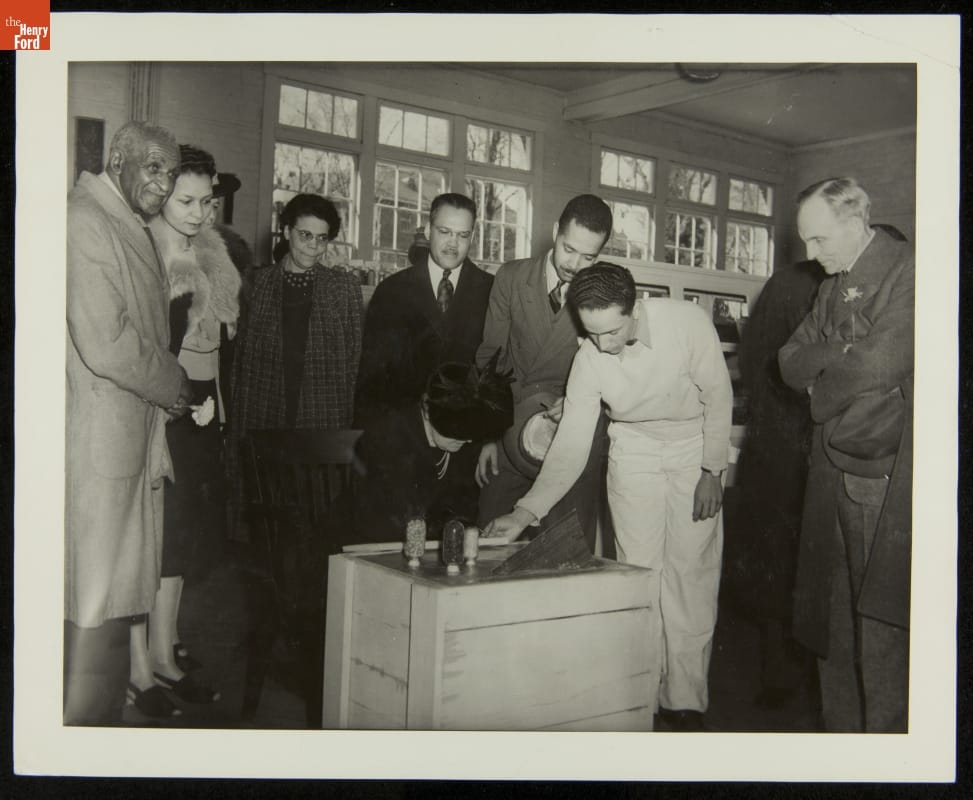
Clara Ford, face obscured by her hat, inscribes her name in a block of concrete during the dedication of George Washington Carver Museum, March 1941, Tuskegee Institute, Alabama. Others in the photograph, left to right: George Washington Carver; Carrie J. Gleed, director of the Home Economics Department; Catherine Elizabeth Moton Patterson, daughter of Robert R. Moton (the second Tuskegee president) and wife of Frederick Douglass Patterson (the third Tuskegee president); Dr. Frederick Douglass Patterson; Austin W. Curtis, Jr.; an unidentified Tuskegee student who assisted with the ceremony; and Henry Ford. / THF213788
Henry Ford inscribing his name in a block of cement during the dedication of George Washington Carver Museum, Tuskegee Institute, March 1941 / THF213790
After the dedication, the Fords ate lunch in the dining room at Dorothy Hall, the building where Carver had his apartment, and toured the veterans’ hospital. They then returned to the Fair Lane railcar and headed for the main rail line in Atlanta for the rest of their journey north.
President Patterson directed a thank you letter to Henry Ford, dated March 14, 1941. In this letter, he commended Clara Ford for her “graciousness” and “her genuine interest in arts and crafts for women, particularly the weaving, [which] was a source of great encouragement to the members of that department.”
The last visit the Fords made to Tuskegee occurred in March 1942. The Fair Lane switched off at Chehaw, where Austin W. Curtis, Jr., met the Fords and drove them to Tuskegee via the grounds of the U.S. Veterans’ Hospital. Catherine Patterson and Clara Ford toured the Home Economics building and the work rooms where faculty taught women’s industries. Clara rode in the elevator that Henry had funded and had installed in Dorothy Hall in 1941, at a cost of $1,542.73, to ease Carver’s climb up the stairs to his apartment.
The Fords dined on a special luncheon menu featuring sandwiches with wild vegetable filling, prepared from one of Carver’s recipes. They topped the meal off with a layer cake made from powdered sweet potato, pecans, and peanuts that Carver prepared.
Tuskegee shared the Fords’ itinerary with Black newspapers, and the April 20, 1942, issue of Atlanta Daily World carried the news, “Carver Serves Ford New Food Products.” They concluded, in the tradition of social columns at the time, by describing what Henry and Clara Ford wore during the visit. “Mrs. Ford wore a black dress, black hat and gloves and a red cape with self-embroidery. Mr. Ford wore as usual an inconspicuously tailored business suit.”
Dr. Patterson wrote to Henry Ford on March 23, 1942, extending his regrets for not being at Tuskegee to greet the Fords. Patterson also reiterated thanks for “Mrs. Ford’s interest in Tuskegee Institute”—“The people in the School of Home Economics are always delighted and greatly encouraged with the interest she takes in the weaving and self-help project in the department.”
The Fords sold the Fair Lane in 1942. After many more miles on the rails with new owners over the next few decades, the Fair Lane came home to The Henry Ford. Extensive restoration returned its appearance to that envisioned by Clara Ford and implemented to ensure comfort for Henry and Clara and their traveling companions. Now the view from those windows features other artifacts on the floor of the Henry Ford Museum of American Innovation, in place of the varied landscapes, including those around the Tuskegee Institute, traveled by the Fords.
A view of the interior of Henry and Clara Ford’s private railroad car, the “Fair Lane,” constructed by the Pullman Company in 1921, restored by The Henry Ford to that era of elegance, and displayed in Henry Ford Museum of American Innovation. / THF186264
Debra A. Reid is Curator of Agriculture and the Environment at The Henry Ford.
1940s, 1930s, 20th century, Alabama, women's history, travel, railroads, Henry Ford Museum, Henry Ford, George Washington Carver, Ford family, Fair Lane railcar, education, Clara Ford, by Debra A. Reid, African American history

This summer, we’re highlighting some of the cocktails and nonalcoholic “temperance beverages” that are available at Eagle Tavern in Greenfield Village. Inspired by history but with a modern flair, these drinks pay homage to the Eagle Tavern barroom’s Michigan history as a sort of “community center.” We’d love for you to stop by and try one of these refreshing concoctions for yourself—or try making them at home. Today’s feature is the Lemon & Ginger Shrub.
Lemon & Ginger Shrub
Fill a 12 oz glass with ice.
Add 1 oz Michigan-made vodka and 2 oz Michigan-made McClary Lemon Ginger Shrub mix.
Fill to the top with soda water.
Additional Readings:
- Eagle Tavern at its Original Site, Clinton, Michigan, February 2, 1925
- Behind the Bar at Eagle Tavern
- Eagle Tavern Happy Hour: Stone Wall Recipe
- Just Added to Our Digital Collections: Eagle Tavern Images
making, restaurants, Greenfield Village buildings, Greenfield Village, Eagle Tavern, recipes, beverages
| “The fact that Webster dwelt and worked on his dictionary there gives this structure singular historic interest…. That all this must disappear shortly before the crowbars of the wreckers is a matter of genuine regret…” —J. Frederick Kelly, New Haven resident and architect, quoted in New Haven Register, July 20, 1936 |

Article from the New Haven Register, New Haven, Connecticut, July 20, 1936. / THF624813
In the mid-1930s, Yale University, owner of the Noah Webster Home on Temple Street in New Haven, Connecticut, decided this former home of one of its notable alumni needed to be torn down. It was the Depression, and Yale’s financial situation required some retrenchment. Tearing down the Webster house, along with eleven other Yale-owned homes, would cut the university’s tax bill and save the expense of maintenance, while providing space for new construction better suited to the university’s needs.
The house came very near to being demolished.
In this comfortable home, completed in 1823 at Temple and Grove streets, Noah Webster had enjoyed an active family life, written many of his publications, and completed his ultimate life’s work—America’s first dictionary. Noah and Rebecca Webster had moved to New Haven in their later years to be near family and friends, as well as the library at nearby Yale College. While living in this house, Webster published his famous American Dictionary of the English Language in 1828.
Silhouette of Noah and Rebecca Webster by Samuel Metford, 1842. / THF119764
What happened to the house after the deaths of Noah in 1843 and Rebecca in 1847? For the next seven decades, the Temple Street house was filled with new generations of Webster descendants and their relations.
The Trowbridge Era
After Noah Webster’s death in 1843, the house became part of Webster’s estate. In his will, his wife Rebecca received the lifetime use of the Temple Street house. In March 1849, executors of the Webster estate, William Ellsworth (a son-in-law) and Henry White, deeded the property to Henry Trowbridge, Jr., a merchant who sold goods imported from the Far East and a director of the New Haven Bank. (Trowbridge took out a mortgage on the house in 1850, probably to compensate the estate for the value of the house.) Trowbridge had married Webster granddaughter Mary Southgate in 1838. Mary had been raised by Noah and Rebecca Webster and had grown up in the Temple Street house. Henry and Mary Trowbridge had six children: five daughters as well as a son who died young. Mary Southgate Trowbridge passed away in May 1860 of tuberculosis at the age of 41.
In 1861, Henry Trowbridge married again, to Sarah Coles Hull. Their son Courtlandt, born in 1870, was the only surviving child of the marriage.
About 1870, prosperous Henry Trowbridge decided to remodel the house, adding a wealth of “updates” in the then-fashionable Victorian style. These included five bay windows, as well as marble fireplace mantles, plaster ceiling medallions, exterior and interior doors, and elaborately carved walnut woodwork on the first floor. Trowbridge also lengthened the first-floor windows and built a brick addition on the back.

Noah Webster Home showing Victorian-era changes, including the bay windows and addition at the rear of the home. Top photo taken about 1927; bottom photo, in 1936. / THF236369, THF236375
Over the years, the house was filled with the rhythms of everyday life and the comings and goings of family. Nine Trowbridge children grew up there—six of them were born in the house and three of them died there. Daughters married and moved out. One Trowbridge daughter made two long-distance visits home during the years she and her merchant husband lived in Hong Kong. Another returned home for a time as a widow with a young child. In the 1910s, during the final years of Trowbridge ownership, the widowed Sarah lived in the house with her son Courtlandt, his wife Cornelia, and their three children.
Webster Home—perhaps a bit overgrown—about 1912. / THF236373
In 1918, the year following his mother’s death, 68-year-old Courtlandt Trowbridge sold the Temple Street house in which he had lived since birth “for the consideration of one dollar,” deeding the property to the Sheffield Scientific School at Yale, located a block from the Webster house on Grove Street. Courtlandt, a Sheffield graduate, then moved to Washington, a rural village in northwest Connecticut, along with his wife, Sarah, and youngest son, Robert.
From Family Home to College Dorm

Postcard, Sheffield Scientific School, Yale College, 1915-1920. / THF624831
Sheffield Scientific School offered courses in science and engineering. Following World War I, its curriculum gradually became completely integrated with Yale University’s—undergraduate courses were taught at Sheffield from 1919 to 1945, coexisting with Yale’s science programs. (Sheffield would cease to function as a separate entity in 1956.) The Sheffield Scientific School used the Webster house as a men’s dormitory for freshmen for almost 20 years.
Postcard, Vanderbilt-Sheffield dormitories on Chapel Street in New Haven, about 1909. / THF624833
The Webster house wasn’t Sheffield’s only dormitory, though. The impressive Vanderbilt-Sheffield dorms, dating from the early 1900s, served most of Sheffield’s students. The Noah Webster Home provided some additional space for freshmen to live.
A view of Temple street about 1927, during the time Yale University used the Webster house (shown at far right) as a dormitory. / THF236367
In 1936, Yale decided that retaining the “non-revenue-bearing” house was not financially viable for the university. It was no longer needed as a dorm because of the construction of Yale’s Dwight College, opened in September 1935. Removing the Webster home would also provide space for growth for the university. (The site would become part of Yale’s Silliman College.)
A Timely Rescue
In early July 1936, Yale University was granted permission to demolish the house. (The louvered, elliptical window was to go to the Yale Art School.) The house was sold to Charles Merberg and Sons, a wrecking company. But there were attempts to save the home. Soon after Yale University was granted a permit on July 3 to tear down the house, the local newspaper, the New Haven Register, began a campaign to save it. New Haven resident Arnold Dana, a retired journalist, offered to contribute to a fund to preserve the house, but no additional offers of funds came. For several weeks, articles appeared in newspapers in New York and other large cities on the subject.
Initial interest in preserving the building by the Society for the Preservation of New England Antiquities (SPNEA, now Historic New England) waned because of the Victorian-era changes. William Sumner Appleton, the society’s founder and a chief force behind the preservation of many historic buildings in New England, thought the building might make an interesting museum if a private individual would take on the project. Appleton said that SPNEA had no funds to do so.
J. Frederick Kelly, a New Haven resident, architect, and author of books on early Connecticut architecture, noted the building’s historical significance and commented on its architecture: “…the fine proportion and delicate scale of the Temple Street façade mark it as one of unusual distinction. The design of the gable … contains a very handsome elliptical louvre … an outstanding feature that has no counterpart in the East so far as I am aware.”
Telegram to Edsel Ford concerning the imminent demolition of the Noah Webster Home in New Haven, Connecticut. / THF624805
On July 29, R.T. Haines Halsey sent a telegram to Edsel Ford. Halsey let Edsel know that the Webster house was “in the hands of wreckers” and that it would fit in well with “your father’s scheme” for Greenfield Village. Immediate action was needed to save the house.
1924 postcard, American wing at the Metropolitan Museum of Art, built to display American decorative arts from the 1600s to the early 1800s. / THF148348
Halsey, a retired New York City stockbroker, was a collector of decorative arts who was instrumental in the opening of the American Wing of the Metropolitan Museum in New York City in 1924. In the 1930s, Halsey had become a research assistant in the Stirling Library at Yale University. Halsey may have chosen to contact Henry through Edsel because of Edsel’s interest in art and involvement with the Detroit Institute of Arts and the Museum of Modern Art in New York City.
On July 27, Ralph J. Sennott, manager of the Wayside Inn in South Sudbury, Massachusetts, a historic inn restored by Henry Ford, sent Ford a letter. (Perhaps it reached Ford about the time that Halsey’s telegram did.) Sennott also made Ford aware that the Webster home was in the hands of the wrecking company and that the building needed to be removed by September 1. The wrecker was willing to sell the house, but demolition work was to begin August 3. Henry Ford paid a $100 deposit on the house on August 2 to prevent demolition going forward. Ford was given until September 15 to make his final decision on acquiring the building.
Henry Ford arrived in New Haven on September 10 to see the Webster home in person. According to Lewis Merberg of the wrecking company, Ford appreciated the building for its historical significance more than for its “antiquity.” Noah Webster likely would have appealed to Ford as the author of the popular “Blue-Backed Speller,” used by many early American schools. Ford completed the purchase, paying about $1000 for the home.
Letter from Harold Davis of the Historic American Buildings Survey to Henry Ford, September 14, 1936. / THF624811
Noting Ford’s interest in the building, Harold Davis, the Connecticut district officer of the Historic America Building Survey, made Ford aware that the organization—whose purpose it was to measure and record historic buildings—had documented the Webster house in 1934. Ford acquired copies of these drawings, which were available at the Library of Congress.
The Noah Webster Home Moves to Dearborn
When Edward Cutler, the man responsible for moving and reassembling buildings in Greenfield Village for Henry Ford, arrived in New Haven in mid-September, wreckers had already removed windows and other parts of the house. The interior was not in the best state of repair—likely a little worse for wear after almost 20 years serving as home to college freshmen. Additional documentation of the house was needed before a wrecking crew disassembled the building under Edward Cutler’s direction. Cutler took more measurements. More photos of the home’s exterior and interior would assist with its reassembly in Greenfield Village.
Edward J. Cutler made detailed drawings of the house before it was dismantled. / THF132776
Image of the back of the Webster home taken in 1936 by a local New Haven photographer, perhaps at the request of Henry Ford or one of his representatives. / THF236377
Interior of house, view from the dining room looking towards the bay window in the sitting room. / THF236381
Edsel’s son Henry Ford II, then a Yale freshman, posed in front of the Noah Webster Home during its dismantling in October 1936. / THF624803
With this move, the Noah Webster Home would shed some of its Victorian-era “modernizing.” Cutler removed the four second-floor bay windows added during the Trowbridge renovation. He did retain some Trowbridge updates—exterior and interior doors, interior architectural details, and the first-floor bay window.
In October 1936, the Webster house was dismantled and packed up in about two weeks, according to Ed Cutler. Then it was shipped to Dearborn.
Webster Home reassembled in Greenfield Village, September 1938. / THF132717
Reassembly in Greenfield Village took about a year. In June 1937, workmen broke ground for the foundation of the home. By the end of December, most of the exterior work had been completed. Progress on the interior continued through the winter months. By July 1938, finishing touches were being added to the house.
Edison Institute High School girls prepare a meal in the Webster kitchen, 1942. THF118924
Until 1946, high school girls from the Edison Institute Schools used the Noah Webster Home as a live-in home economics laboratory—a modern kitchen was provided in the brick addition built on the back of the home. Henry Ford had opened the school on the campus of his museum and village in 1929.
Webster dining room in 1963. / THF147776
The Noah Webster Home finally opened to the public for the first time in 1962, telling the story of Webster and America’s first dictionary. Yet the Webster house was furnished to showcase fine furnishings in period room-like settings, rather than reflecting a household whose elderly inhabitants started housekeeping decades before.
Noah Webster Home Today

Noah Webster Home in Greenfield Village. / THF1882
In 1989, after much research on the house and the Webster family, museum staff made the decision to return the entire home to its original appearance during the Websters’ lifetime. The remaining Victorian additions were removed, including the first-floor bay window, interior woodwork, and interior doorways added during the Trowbridge era.
Noah Webster Home sitting room after 1989 reinstallation. / THF186509
Webster family correspondence and other documents painted a picture of a household that included not only family activities, but more public ones as well. Based on this research, curators created a new furnishings plan for the reinstallation. Now visitors could imagine the Websters living there.
Pay the Websters a Visit
Whew—close call. In 1936, the Noah Webster Home was saved in the nick of time.
Now that you know “the rest of the story,” stop by the Webster Home in Greenfield Village. Enjoy this immersive look into the past and its power to inspire us today. Hear the story of the Websters’ lives in this home during the 1830s, learn about Noah’s work on America’s first dictionary and other publications, and experience the furnished rooms that give the impression that the Websters still live there today.
For more on the Noah Webster Home, see “The Webster Dining Room Reimagined: An Informal Family Dinner.”
Jeanine Head Miller is Curator of Domestic Life at The Henry Ford. Many thanks to Sophia Kloc, Office Administrator for Historical Resources at The Henry Ford, for editorial preparation assistance with this post.
Noah Webster Home, Henry Ford, home life, by Jeanine Head Miller, Greenfield Village history, Greenfield Village buildings, Greenfield Village

